#mass appeal magazine
Explore tagged Tumblr posts
Text


Polaroid and Digital shot of from Kundle Martins of a Irak Graffti crew by Kenneth Cappello for Mass Appeal Magazine
#kundle martins#irak#Kenneth cappello#mass appeal#mass appeal magazine#mine#belovedbluv#grillz#sunglasses#pink
4 notes
·
View notes
Text
notes on Primo's characterization 💖
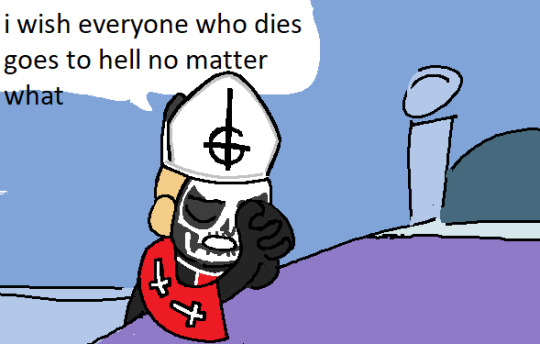
let's talk about Primo! i think he's a really, really interesting character!
i've said before that i think Primo is the only one of the brothers who takes the whole ~satanic death cult trying to bring the end of the world~ thing seriously.
Primo was indeed very serious about the cult. maybe too serious? even some other members of the cult dislike that about him.
NAMELESS GHOUL: The first Papa Emeritus was someone very rigid, very strict, and very solemn. A real son of a bitch! (laughs) To be honest, we don’t miss him at all! MyRock #44 (2017) translated from French by @ a-wandering-ghoulette)
the best source of Primo characterization is a 2010 interview with Sweden Rock Magazine where Primo and the Nameless Ghouls kidnapped the interviewer. though i quote *a lot* of it here, i strongly recommend reading the full interview because it is truly fascinating. notably, Primo himself speaks in this interview rather than a Nameless Ghoul.
Primo is a misanthrope who believes humans are "vermin" that have doomed themselves due to their "intellectual decline". in his eyes, they are unworthy of life and will eventually be destroyed.
“Human beings are vermin, thus the end of humanity is ultimately a good thing. We play but a vanishingly microscopic role in this cosmos of nothingness.”
The devil-worshipping organization that the Ghost leader speaks of is claimed to operate on a worldwide level and among many different areas: from politics and business to religious movements, in the entertainment industry and on the street. It does not have a name, but its existence “can most easily be explained as a living and ongoing result of humanity’s intellectual decline and eventual decay.”
Primo affirms Ghost's mission statement as originally presented in the band's old Myspace page: to spread the devil's influence and convince other people that humanity deserves its inevitable end.
According to the statement on the band’s page, Ghost’s main mission is to trick mankind into believing that the end of the world is ultimately a good thing. “Our only task is to accompany the world’s downfall.”
A question comes to mind: wouldn’t the band, which with its poppy hard rock could by all means appeal to a much wider audience than ordinary black metal acts, gain more attention by engaging in more commercial modes of expression? “We have other entertainment groups within our organization who are doing just that. Our task is to emphasize the devil’s message in the part of society that has, to varying degrees, already accepted it. It’s directed at the social grouping that goes to the type of concerts that we perform. Our goal is to be able to carry out our black mass, our ritual, for them. Other members of the cult work with far more subtle modes of expressions, better suited for consumers who are not as receptive to the truth.”
though he openly calls the organization a cult, his religious belief is sincere.
to Primo, the band's anonymity and use of costumes are a way of showing reverence and humility in their task. if Satan is the Father, and Antichrist is the Son, the band is the (unholy) Ghost: the force which connects humanity to the power of the Father and the Son. for the audience to think of Primo or the Nameless Ghouls as individual people would distract from their message. when he takes on the role of Papa, he becomes one with their cause.
You refer to yourselves as a group of nameless spirits - should this be taken literally? Is the band actually something other than human? “To make it easier for mortals to deal with the fact that we, as individuals, have no significance in this experience, we have chosen to act as ghosts - hollow and diffuse.”
Why did you, as a leader, choose an outfit so similar to the one worn by the Catholic Pope? “For the Pope it is a way of showing reverence and seriousness, and at the same time humility before his task. He uses it to step into the body that is the essence and the fog, something we advocate too. It is our way of becoming one with the fog.” Things become clearer when the leader speaks of the meaning behind the name of the band: “Akin to the tripartite view so stubbornly proclaimed by the Christian faith, we too believe there is magic in the concept of three and we are part of it: there is a god, Satan, a son, Antichrist, and a ghost in the middle that is the inexplicable - the fog.”
Primo has a theistic view of Satan, believing he is real deity who speaks through / inspires the band's music. in this way, the Ghoul Writer could be considered a sort of prophet to him.
That’s right. Ghost have their music written for them. In one online interview, a so-called “ghoul writer” is mentioned who supposedly composes melodies and lyrics with the help of ungraspable powers from beyond – devilish whispers instruct him which words should accompany which chords, and so forth. “There is indeed a human individual who composes patterns of tones and words which operate ever so beautifully in unison. However, I am of the belief that there is a higher being who speaks through this individual,” asserts the Pope.
like a proper cultist, Primo cannot imagine having a life / identity outside of the cult. he remembers that there was once a time when he was not a member of the cult, but he cannot remember what it was like to be that person. his devotion to the cult has been a core part of who he is for a very long time.
How he got involved in this movement and dedicated his life to Satan, he has a hard time answering. After a long silence, the singer says: “I find it very difficult to remember the life I had before I found the darkness. It is therefore very difficult to answer your question. My memory doesn’t go that far.” Surely the Pope must remember something? “I cannot remember a time when I did not find myself part of the dark energy. That does not mean that I remember nothing from my past life, only that I cannot remember how I felt then. This is because it was a time when I did not know very much.” Was it by coming into contact with other members of the organization that you found this darkness? “As I said, I do not remember when this happened. But I think…” He chooses his words carefully. “… I believe that, like many others, I was woven into this dark through subtle, human components found within it. Once again, my intellect was not as developed as it is now, so I have great difficulty in explaining what happened - when and where, and to what extent.”
while he cannot say exactly what happened to him or when, Primo seems to have had genuine spiritual experiences. he was always connected to the dark energy, and he feels that he became awakened and that his intellect has developed since he truly found his faith.
despite being a misanthrope, Primo admits he was brought into the darkness by some sort of human connection. he might actually have the capacity to care about some people.
in a Kerrang feature where Primo gets quizzed on "demonology, serial killers and stuff like that", he says the cult knew witches who were burned at the stake, but he doesn't like to talk about it. it stood out to me that he says he doesn't want to talk about it, because he speaks so openly and matter-of-factly about other dark / upsetting topics. at the very least, it appears he doesn't like it when bad things happen to other members of the cult.
WHAT DOES THE PHRASE MALLEUS MALEFICARUM TRANSLATE AS IN ENGLISH? A) HAMMER OF THE WITCHES B) HAMMER OF THE DEMONS C) HAMMER OF THE GODS PAPA: “That would be the witch-hammer. We knew some Witches, but unfortunately a lot of them were taken away.” KERRANG!: “As in burned at the stake?” PAPA: “Correct. But I don’t like to talk about that. (Answer: A) ✔
he seems to be quite pleased about other people dying, though. and he is certain they all go to Hell.
6. NAME ANY TWO OF THE THREE ORIGINAL MEMBERS OF MAYHEM. PAPA: “Though one was not an original member two of the band are actually burning in Hell, and they’re good guests, certainly. But yes, I will say Euronymous and Necrobutcher.” (Answer: Euronymous, Necrobutcherr, Manheim) ✔ 7. WHAT WAS THE NAME OF THE SHIP THAT WAS DISCOVERED FLOATING ABANDONED AND UNMANNED IN THE ATLANTIC OCEAN IN DECEMBER 1872? PAPA: “It was that ship with such a heavenly name, the lady Mary Celeste.” KERRANG!: “And can you finally tell us where all the people went?” PAPA: I’ll check the records. Obviously they’re all in Hell now, but the way they got there is a little cloudy. But then our Lord too works in mysterious ways…“ (Answer: Mary Celeste) ✔
some of Primo's other responses in this article reveal he has a dark sense of humor and perhaps cruel inclinations. when talking about possessions done by the cult, he says "sometimes you just want to do it for the hell of it" and "you want to make a bit of sport out of it", referring to a possession that (allegedly) influenced a serial killer. he refers to the victims of these possessions as "poor [name]", but his remarks on their misfortune don't indicate any actual remorse or sympathy. it might even be intentionally ironic.
5. WHICH PAINTER ALLEGEDLY UNDERWENT AN EXORCISM IN 1947? PAPA: “Poor Salvador Dali. You know we had his missus possessed as well, all in the name of Satan…” KERRANG!: Is possession something that’s done for serious reasons or just to pass the time? “Well sometimes you just want to do it for the hell of it…” (Answer: Salvador Dali) ✔
13. WHAT AMERICAN SERIAL KILLER CLAIMS HE WAS COMPELLED TO COMMIT HIS MURDERS BY A DEMON THAT POSSESSED HIS NEIGHBOUR’S DOG? PAPA: 'That was that poor boy, the Son Of Sam. That sure was a successful possession, although it did involve far too much crotch-sniffing and turd-eating.“ KERRANG: "Is it easier to possess a dog than to possess a person?” PAPA: “Not necessarily, but you want to make a bit of sport out of it.” (Answer: David Berkowitz/Son Of Sam) ✔
also, many of the events Primo speaks about would've happened before he was born or when he was very young, so it seems he's studied the cult's history very well, and he keeps tabs on their current activities. he does his research!
and as a fun fact: Primo is pretty good at math :)
14. IF YOU’RE TRICK OR TREATING AND THREE HOUSES GIVE YOU SEVEN SWEETS, TWO GIVE YOU FOUR, AND ONE GIVES YOU NINE, AND YOUR PARENTS THEN DOUBLE WHAT YOU HAVE, HOW MANY SWEETS DO YOU END UP WITH? PAPA: “76.” KERRANG!: “That was alarmingly fast, sir. Are good mathematical skills important when you’re burning in the fiery pits of Hell?” PAPA: “We all have our different strengths, but of course the number we are most used to is 666…” (Answer: 76) ✔
there's not a lot of information about Primo, and what exists is hard to find, but i live to bring knowledge to the people 🫡. these are all the sources i have on hand that talk about Primo. if anyone else has other articles / videos talking about Primo, i'd really appreciate it if you shared them!
#this one is more of a notes post than an analysis post#but i think this stuff is worth sharing!#papa emeritus i#primo#analysis#quotes#the band ghost lore#radley post#headcanon#? not really but i'll put it in the tag anyway
287 notes
·
View notes
Text
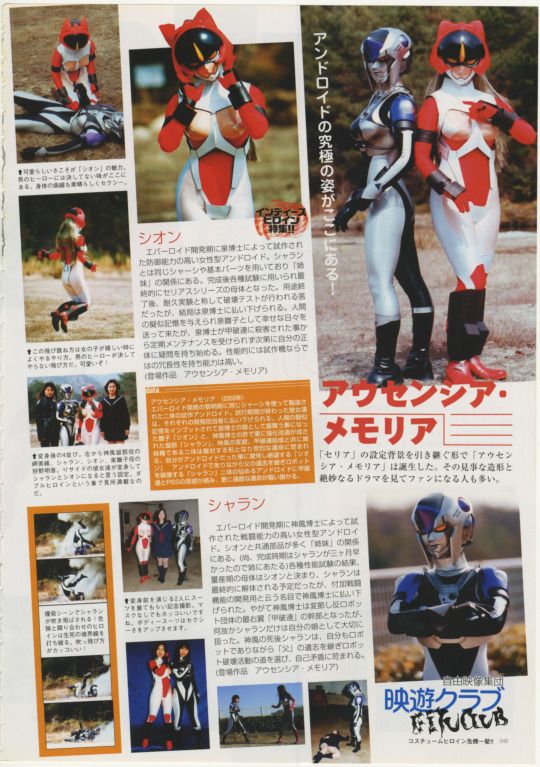
One page about Eiyu Club film "Ausencia Memoria" from HEROINE magazine Volume 2 (2004). The film is the sequel to "Evaroid Seria". This edition focused on independent heroine tokusatsu production companies such as Eiyu Club, Center Island, and more.
English translation below the cut:
[White text on large image of Sharan and Shion on right]
The ultimate androids are here!
[Red text below large image, with smaller black text below]
Ausencia Memoria
"Ausencia Memoria" was created, set in the world of "[Evaroid] Seria". Many people have become fans of the series due to its stunning design and exquisite drama.
[Text below middle-top image of red and white Evaroid “Shion”]
Shion
[Text with red design behind it] Indie Heroine Special!
A female android with high defensive capabilities who was prototyped by Dr. Izumi during the development of Evaroids. She uses the same chassis and basic parts as Sharan, making them have a "sister"-like relationship. After completion, she was used in various tests, and eventually became the basis for the Seria series. After her use was completed, a destructive test was supposed to be conducted on her under the guise of a durability experiment, but she was eventually sold to Dr. Izumi. She was given pseudo-human memories and lived a happy life as Izumi Hinako, but after Dr. Izumi was killed by the Executive Destruction Federation, she was unable to receive regular maintenance and gradually began to question her true body. In terms of performance, she has the excess capacity unique to a prototype and is highly capable. (Appears in “Ausencia Memoria”)
[Text to the left of the purple and silver android in the bottom right]
Sharan
A high-combat-capability female-type prototype android developed by Dr. Kamikaze [TN: also called “Jinpu” in the movie] during the Evaroid development period. Sharing many components with Shion, she is considered her "sister." (However, since Sharan was completed three months earlier, she is regarded as the elder sister.) Following various performance evaluations, Shion was chosen as the production model for mass manufacturing, and Sharan was initially scheduled for dismantling. However, under the pretext of using her for additional combat function development, she was handed over to Dr. Kamikaze. Dr. Kamikaze eventually defected and became a key figure in the radical anti-robot organization the Executive Destruction Federation. Yet, for some reason, he treated Sharan as his own daughter and cherished her. After Kamikaze’s death, Sharan, despite being a robot herself, chose to carry on her "father’s" will and embarked on a path of robot destruction, plagued by the contradictions of her own existence. (Featured in: Auscensia Memoria)
[Text in orange box]
Data
Ausencia Memoria (2003)
During the early days of Evaroid development, two prototype androids were manufactured using the same chassis. After their trial period ended, they were handed over to their respective developers. Hinako, later known as Shion, was implanted with artificial human memories and raised as Dr. Izumi’s daughter. Meanwhile, Sharan underwent further enhancements and modifications under Dr. Kamikaze [TN: also called “Jinpu” in the movie]. With Kamikaze’s defection and the formation of the Executive Destruction Federation, the two sister units found themselves on opposing sides, bound by a relentless fate. Shion is shocked and devastated upon learning she is an android. Sharan, an android who, despite her nature, inherited her father’s will and dedicated herself to destroying robots. As the ambitions of the Executive Destruction Federation and PSS intertwine, an even harsher fate awaits these two tormented androids.
[Top right image of Shion kneeling over Sharan]
Shion's appeal is her cuteness. She has a unique charm that male heroes never have. Her curves are also wonderfully sexy.
[Second from top image of Shion jumping]
This is the way girls often jump when they're happy. Male heroes never do it like this. Cute!
[Third from the top, group shot of Shion and Sharan in suits, the face actresses flanking the suit actresses]
The four of them lined up after transforming. From the left: Mio Misaki as Luna Kamikaze, Sharan, Shion, and Sayaka Kano as Hinako Izumi. The setting is that the girls flanking Sharan and Shion transform into them. With double the amount of usual heroines, there's plenty to see.
[Bottom right, series of four small images of Sharan doing an action sequence]
Sharan is blown away in an explosion scene! The heroine, who lives side by side with danger, straddles the line between life and death. How she’s blown away looks so cool!
[Below image of 3 people: Shion, Sayaka Kano [Shion’s face actress], and Sharan]
We had the two actresses, who were acting out their pre-transformation poses, wear the suits and take a commemorative photo. They look cool even without masks, and the bodysuits make them so sexy.
[Bottom right blue and black text]
Free Video Group
Eiyu Club [TN: Also in English, the nearly illegible font]
Costumed Heroines in Danger!!
#tokusatsu#eiyu club#2000s#gynoid#robot girl#It is SO funny how I learn critical information from these articles that were not told to me in the movies
64 notes
·
View notes
Text
About the entanglement of "science" and Empire. About geographic imaginaries. About how Empire appeals to and encourages children to participate in these scripts.
Was checking out this recent thing, from scavengedluxury's esteemed series of posts looking at the archive of the Budapest Municipal Photography Company.
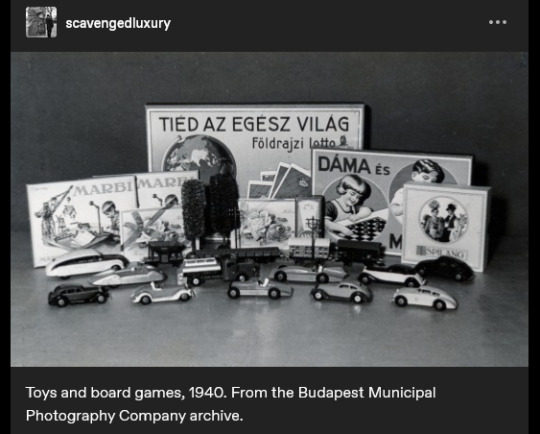
The caption reads: "Toys and board games, 1940." And I think the text on the game-box in the back says something like "the whole world is yours", maybe?
(The use of appeals to science/progress in imperial narratives probably already well-known to many, especially for those familiar with Victorian era, Edwardian era, Gilded Age, early twentieth century, etc., in US and Europe.)
And was struck, because I had also recently gone looking through nemfrog's posts about the often-strange imagery of children's material in late nineteenth- and early twentieth-century US/Europe. And was disturbed/intrigued by this thing:

Caption here reads: "Game Board. Walter Mittelholzer's flight over Africa. [...] 1931. Commemorative game board map of Africa for a promotional game published for the N*stle Company, for tracking the trip of Walter Mittelholzer across Africa, the first pilot to fly a north-south route."
Hmm.
I went to learn more about this: Produced in Switzerland. 1930s-era national(ist) aspirations in Africa. "Africa is for your consumption and pleasure. Brought to you by the N#stle Company!" (See the name-dropof N#stle at the bottom of the board.) A company which, in the preceding decade, had shifted focus to expand its cacao production (which would be dependent on tropical plantations). Adventure, excitement, knowledge, science, engineering prowess, etc. For kids! In 1896, Switzerland had hosted a "human zoo" at the Swiss Second National Exhibition in Geneva, where the "Village Noir" exhibit put living people on display; they were over two hundred people from Senegal, who lived in a "mock village" in Geneva's central square.
Another, from a couple decades earlier, this time English-language.
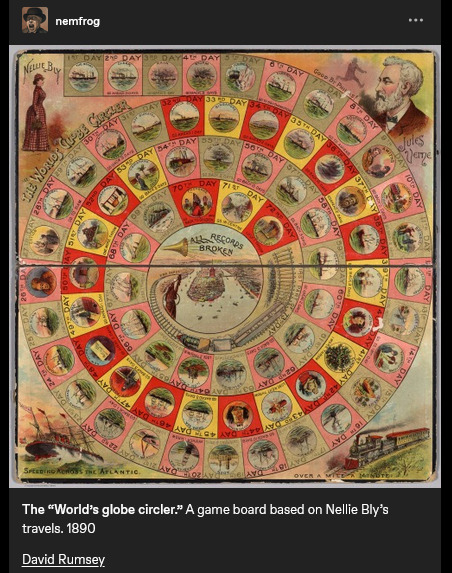
Caption reads: "The "World's globe circler." A game board based on Nellie Bly's travels. 1890." At center, a trumpet, and a proclamation: "ALL RECORDS BROKEN".
Went to find more info: Lithographed game board produced in New York. Images on the board also show Jules Verne stuff; Bly was attempting to emulate the journey of the character Phileas Fogg in Verne's Around the World in Eighty Days (1872).
Same year that the United States "closed the frontier" and conquered "the Wild West" (the massacre at Wounded Knee happened in December 1890). A couple years later, the US annexed Hawai'i; by decade's end, the US military was in both Cuba and the Philippines. The Scramble for Africa was taking place. At the time, Britain especially already had a culture of "travel writing" or "travel fiction" or whatever we want to call it, wherein domestic residents of the metropole back home could read about travel, tourism, expeditions, adventures, etc. on the peripheries of the Empire. Concurrent with the advent of popular novels, magazines, mass-market print media, etc. Intrepid explorers rescuing Indigenous peoples from their own backwardness. Many tales of exotic allure set in South Asia. Heroic white hunters taking down scary tigers. Elegant Englishwomen sipping tea in the shade of an umbrella, giggling at the elephants, the local customs, the strange sights. Orientalism, tropicality, othering.
I'd lately been looking at a lot of work on race/racism and imperative-of-empire in British scientific and pop-sci literature, especially involving South and Southeast Asia. (From scholars like Varun Sharma, Rohan Deb Roy, Ezra Rashkow, Jonathan Saha, Pratik Chakrabarti.) But I'd also lately been looking at Mashid Mayar's work, which I think closely suits this kinda thing with the board games. Some of her publications:
"From Tools to Toys: American Dissected Maps and Geographic Knowledge at the Turn of the Twentieth Century". In: Knowledge Landscapes North America, edited by Kloeckner et al., 2016.
"What on Earth! Slated Globes, School Geography and Imperial Pedagogy". European Journal of American Studies 16, number 3, Summer 2020.
Citizens and Rulers of the World: The American Child and the Cartographic Pedagogies of Empire, 2022.
Discussing her book, Mayar was interviewed by LA Review of Books in 2022. She says:
[Quote.] Growing up at the turn of the 20th century, for many American children, also meant learning to view the world through the lens of "home geography." [...] [T]hey inevitably responded to the transnational whims of an empire that had stretched its dominion across the globe [recent forays into Panama, Cuba, Hawai'i, the Philippines] [...]. [W]hite, well-to-do, literate American children [...] learned how to identify and imagine “homes” on the map of the world. [...] [T]he cognitive maps children developed, to which we have access through the scant archival records they left behind (i.e., geographical puzzles they designed and printed in juvenile periodicals) [...] mixed nativism and the logic of colonization with playful, appropriative scalar confusion, and an intimate, often unquestioned sense of belonging to the global expanse of an empire [...]. Dissected maps - that is, maps mounted on cardboard or wood and then cut into smaller pieces that children were to put back together - are a generative example of the ways imperial pedagogy [...] found its place outside formal education, in children's lives outside the classroom. [...] [W]ell before having been adopted as playthings in the United States, dissected maps had been designed to entertain and teach the children of King George III about the global spatial affairs of the British Empire. […] [J]uvenile periodicals of the time printed child-made geographical puzzles [...]. [I]t was their assumption that "(un)charted," non-American spaces (both inside and outside the national borders) sought legibility as potential homes, [...] and that, if they did not do so, they were bound to recede into ruin/"savagery," meaning that it would become the colonizers' responsibility/burden to "restore" them [...]. [E]mpires learn from and owe to childhood in their attempts at survival and growth over generations [...]. [These] "multigenerational power constellations" [...] survived, by making accessible pedagogical scripts that children of the white and wealthy could learn from and appropriate as times changed [...]. [End quote.] Source: Words of Mashid Mayar, as transcribed in an interviewed conducted and published by M. Buna. "Children's Maps of the American Empire: A Conversation with Mashid Mayar". LA Review of Books. 11 July 2022.
Some other stuff I was recently looking at, specifically about European (especially German) geographic imaginaries of globe-as-playground:
The Play World: Toys, Texts, and the Transatlantic German Childhood (Patricia Anne Simpson, 2020) /// "19th-Century Board Game Offers a Tour of the German Colonies" (Sarah Zabrodski, 2016) /// Advertising Empire: Race and Visual Culture in Imperial Germany (David Ciarlo, 2011) /// Learning Empire: Globalization and the German Quest for World Status, 1875-1919 (Erik Grimmer-Solem, 2019) /// “Ruling Africa: Science as Sovereignty in the German Colonial Empire and Its Aftermath” (Andrew Zimmerman. In: German Colonialism in a Global Age, 2014) /// "Exotic Education: Writing Empire for German Boys and Girls, 1884-1914". (Jeffrey Bowersox. In: German Colonialism and National Identity, 2017) /// Raising Germans in the Age of Empire: Youth and Colonial Culture, 1871-1914 (Jeff Bowersox, 2013) /// "[Translation:] (Educating Modernism: A Trade-Specific Portrait of the German Toy Industry in the Developing Mass-Market Society)" (Heike Hoffmann, PhD dissertation, Tubingen, 2000) /// Home and Harem: Nature, Gender, Empire, and the Cultures of Travel (Inderpal Grewal, 1996) /// "'Le rix d'Indochine' at the French Table: Representation of Food, Race and the Vietnamese in a Colonial-Era Board Game" (Elizabeth Collins, 2021) /// "The Beast in a Box: Playing with Empire in Early Nineteenth-Century Britain" (Romita Ray, 2006) /// Playing Oppression: The Legacy of Conquest and Empire in Colonialist Board Games (Mary Flanagan and Mikael Jakobsson, 2023)
#mashid mayar book is useful also the Playing Oppression book is open access online if you want#in her article on slated globes mayar also mentions how european maps by 1890s provoked a sort of replete homogenous filling in of globe#where european metropole thought of itself as having sufficiently mapped the planet by now knit into neat web of interimperial trade#and so european apparent knowledge of globe provided apparently enlightened position of educating or subjugating the masses#whereas US at time was more interested in remapping at their discretion#a thing which relates to what we were talking about in posts earlier today where elizabeth deloughrey describes twentieth century US#and its aerial photographic and satellite perspectives especially of Oceania and Pacific as if it now understood the totality of the planet#ecologies#tidalectics#geographic imaginaries#mashid mayar#indigenous pedagogies#black methodologies#tigers and elephans#victorian and edwardian popular culture#my writing i guess
141 notes
·
View notes
Text
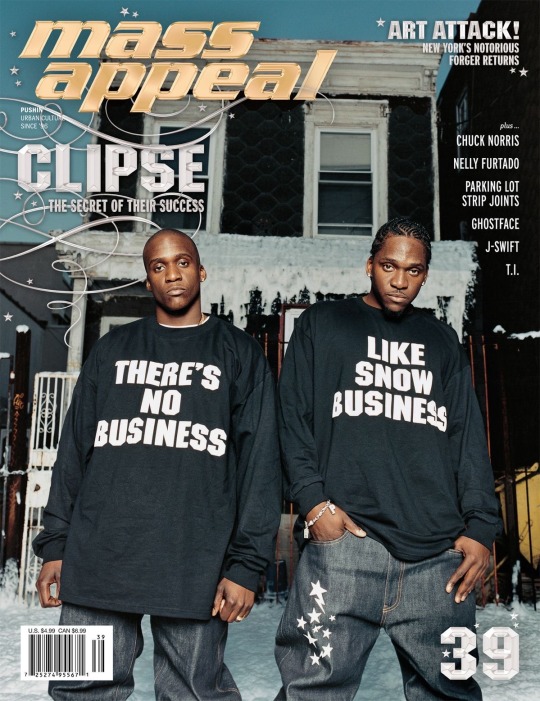

clipse for mass appeal magazine (2006)
275 notes
·
View notes
Text
This is the cover of the current issue of Harper's (not yet online):

The 14-page propaganda piece, by Ben Ehrenreich, is remarkable in how one-sided it is - even for him. The theme of the article is that Palestinians in the West Bank tried non-violence but the evil Jews kept attacking them for no reason, so now they are sadly forced to become violent.The central falsehood of the article is the myth of historical Palestinian nonviolence.Some version of what has come to be called nonviolent resistance dates back more than a century....The idea is simple: to stand together, to refuse the fate chosen for you by your oppressor, and with your courage inspire others to do the same. That was the basis for mass mobilization during the uprising of 1936, throughout the First Intifada in the late Eighties and early Nineties, and in the early weeks of the next one, the fall of 2000. As the Second Intifada dragged into its third year and the losses piled up, nonviolent tactics gained their appeal.
About 400 Jews were killed in the 1936-39 "revolt." About 277 Israelis were killed in the "non-violent" first intifada. And the "early weeks " of the second intifada featured the murders of about 12 Israelis including the vicious lynching of two Israelis who made a wrong turn into Ramallah.
This is the tone of the entire article. The atrocities of October 7 are not mentioned. Terror attacks against Israeli civilians since that date - at least 30 killed by West Bank Palestinians - are not mentioned at all. The article implies that the only "resistance" since October 7 is militants defending their homes in Jenin and Tulkarem, not murdering Jewish civilians.
Astoundingly, the word "Hamas" is not mentioned once - even though it is the most popular political group in the West Bank. Not only that, but Hamas tried to spread the October 7 attacks into the West Bank and wanted to activate sleeper cells there, which would explain Israel's aggressiveness in the territories in the weeks and months afterwards.
Of course, Harper's and Ehrenreich don't want their readers to know this.
The entire article is riddled with falsehoods - claiming that 70,000 were killed in Gaza, way beyond what even Hamas claimed. Or even small details like this:
Shireen Abu Akleh was shot to death by an Israeli soldier in May 2022. The monument erected to her had been bulldozed. Across the street was the new martyrs’ cemetery, built for Palestinians killed by Israeli forces. The earliest graves dated to July 2023, and it was already half full.
The cemetery was there when Akleh was killed.
Manal Tamimi is presented as a non-violent peace activist, while her social media is filled with celebrations of terror attacks. And Ehrenreich knows this quite well, because there have been articles criticizing his praising of the Tamimi family in years past.

This is not journalism. This is curated anti-Israel propaganda.
That this level of distortion passed editorial review at one of America’s most prestigious magazines says more about Harper’s than it does about Ehrenreich.
37 notes
·
View notes
Text
The court's 6-3 conservative majority has expanded gun rights but has also shown a reluctance in recent months to take up new cases on the scope of the right to bear arms.
June 2, 2025, 6:43 AM MST / Updated June 2, 2025, 11:35 AM MST
By Lawrence Hurley
WASHINGTON — The Supreme Court on Monday declined to hear two major gun cases challenging a Maryland law that bans assault-style weapons, including the AR-15 semiautomatic rifle that has been used in high-profile mass shootings, and a Rhode Island restriction on large-capacity magazines.
As a result, the two laws remain in effect. Litigation over similar bans across the country is ongoing, and the issue is likely to return to the justices.
Janet Carter, a lawyer at gun control group Everytown Law, welcomed the developments in both cases.
“Courts of appeals across the country have consistently and correctly upheld laws like these — with countless communities safer as a result,” she said in a statement.
The Firearms Policy Coalition, a gun rights group that was among those challenging the Maryland law, issued a statement saying it was “disappointed that some members of the Supreme Court did not have the judicial courage to do their most important job and enforce the Constitution.”
The group called on the Trump administration to support gun rights activists in future cases.
The court has a 6-3 conservative majority that has expanded gun rights but has also shown a reluctance in recent months to take up a new case on the scope of the right to bear arms under the Constitution's Second Amendment.
27 notes
·
View notes
Note
Hi wolfstar librarian,
I am wondering what are your thoughts on an increasing number of wolfstar writers on ao3 using gen AI, without disclosing it.
There are a couple of new authors with really popular fics that are very likely using AI and it just makes me so sad.
I asked one of the authors about it (privately) and they just deleted their whole tumblr without saying a word. Their tumblr was made just to promote the fic and now they’re posting multiple long fics with the most popular tropes, to appeal to a mass audience, at the same time, there is just no way they’re writing it themselves. Someone even asked them, how do you have time to write so many words/fics? Well they don’t!!! It’s ai!!!! Their fic is getting lots of comments praising their work, I’ve seen edits made for this fic, and it’s just so unfair to both other authors and readers.
It just really frustrates me because there are so many brilliant authors in the fandom and now these people using ai are ruining it for everyone and destroying the credibility of the fandom.
What do you think we as readers should do??? I just can’t make peace with how unfair it is to everyone.
This. Keep doing this.
Keep pointing it out that you recognize they didn’t write it themselves.
Keep commenting on “their” fics. Respond to people’s comments making sure they know it’s AI and recommend something else to them.
Promote ACTUAL authors as much as you can and comment on their fics so they don’t lose motivation.
Quote the AI fics and gather people around to help you shame people for trying to trick you.
Brainstorm with friends. Maybe you all make or support a fanfic competition where you don’t allow AI works, and the theme is “shame on you” with the joke being AI “authors” should be ashamed. Idk. But definitely talk to people. Keep it a part of of the conversation so it doesn’t become so normalized we forget we should be offended.
Volunteer for AO3. And talk to them. Maybe they can add a check box for AI works (many social media accounts have this as an option), or maybe they can add an AI reporting feature.
TBH I don’t have a solution that I’m sure will work, but I love that you care.
And I think in this increasing digitally over saturated age, I’m finding myself more and more inclined to go back to the physical.
Fanfic started as printed out stories that friends would swap at cons. So starting printing YOUR OWN works (never ever ever print someone else’s without their explicit consent) and mail them to friends. Start a magazine (can be online too) where people can submit their written fics.
This post is getting long, but let me end with this: people see AI fanfic as a cheat code to popularity. Make it clear to them they will never escape the truth.
#in my villain era#ai fanfic#anyone else more and more sure we’re gonna become like the movie idiocracy?
39 notes
·
View notes
Text

It Was Fun While it Lasted by Frederick A. Birmingham, published in 1960, is a memoir of life in white Harlem between 1915 and 1925.
From the Dartmouth alumni magazine: By Frederic A. Birmingham '33. Philadelphia: J. B.Lippincott Co., 1960. 224 pp. $3.95.
A joyous boyhood in Harlem forty years ago is the subject of Mr. Birmingham's warmhearted book about days that in retrospect seem so much more appealing than those enjoyed by the motorized and gadget-minded youngsters of today. As the title of the book suggests, there was fun of a special kind, and the author was lucky enough to have his boyhood pleasures enhanced by a delightful family. Former editor and now a free-lance writer, he is able to tell his story in a most readable and amusing way. For light reading, especially at this time of year, here is just the book.
It Was Fun While It Lasted is of the "life with father" genre. And Papa Birmingham dominates the book as he apparently dominated the family, all in a firm but charming way. Meticulous in dress, ramrod straight as a gentleman should be, expert in good food and drink, he took care of Fun in the family while Mama Birmingham took care of Faith. It was he who thought up the things to do on Sunday afternoon and who made each outing an experience. Typically funny is the account of Papa's handling of the family car like a horse on wheels. Never flabby in his thinking, he divided all women into two classes—those who are always smelling something burning and those who go through life hearing burglars.
Mr. Birmingham's reminiscences will have special appeal for those who knew Harlem when it really was the "Happy Valley," and who remember specific names and places and such things as the Hudson River Day Line and the Fort Lee Ferry. But there is nostalgia also for the reader whose boyhood anywhere coincided with silent movies, cobblestone streets, horse-drawn fire engines, and open trolley cars in the summer, as this reviewer's did in Washington. And for the general reader, with or without nostalgia, here is a warm and affectionate account of family life in simpler and less hectic days.
from Stuff Nobody Cares About: The action takes place from approximately 1915–1925, when Birmingham was between the ages of 4 and 14.
Many of the stories revolve around “papa” John F. Birmingham. John Birmingham was a Masonic president and an operator and eventual proprietor of a Baltimore Dairy Lunch Restaurant at 107 West 125th Street from the early 1900s until retiring just before his death at age 79 in 1950.
The Baltimore Dairy Lunch restaurants, which I had never heard of, were predecessors of fast food service during the first wave of mass consumerism. A customer would get their food at the counter and carry it to an uncomfortable one-arm lunch chair, similar to a modern high school or college seat. The idea was to purchase your inexpensive, but tasty food, eat, and leave as quickly as possible. At one time Baltimore Dairy Lunch outnumbered Child's Restaurants, another national restaurant chain.
However none of the book’s tales are about John Birmingham's restaurant, but tell of swimming in the Hudson River, family life, religion, neighbors, automobile trips, parks, movies, neighborhood shopping and school days.
Photo: Stuff Nobody Cares About
#vintage New York#1920s#vintage Harlem#white Harlem#memoirs#1920s Harlem#It Was Fun While it Lasted#1920s New York#old Harlem#books#old NYC#old New York#nostalgia#Frederic A. Birmingham
29 notes
·
View notes
Text

Harry Styles has become synonymous with ‟sexiest man alive” and ‟world's sexiest man” simply by existing but at what cost?
DISCLAIMER: I own no pictures, articles, videos, excerpts used citations will follow nor am I affiliated with H / my take
Here I will take you down memory lane magnifying Harry's image from the start of X Factor circa 2010 to present day; with a fine eye pertaining to his sex appeal and womanizer narrative depicted in the limelight and mass media. As boyband 1D began to rise to fame the general public became fixated on Harry's sexual attributes.
Harry Styles appears to be the whole package. He has talent, wit, humor, a sensitive heart and looks but the harsh reality of living in a superficial world is: physical appearances are favored over substance. In result conventionally attractive people like Harry fall subject to heavy sexualization. Harry's professional music career started in 2010 as did the narrative.

2010
April 11th Harry auditions for the X Factor at the age of 16 years old

Harry is selected to be in a 5-part boyband 3 months later in July (birth of 1D)
Sep 26th Harry stars in a X Factor clip that aired with Katie a potential love interest and multiple other female contestants simultaneously


I'M JUST A TEENAGE DIRTBAG BABYYYYY Harry is portrayed to be a manwhore/player multiple women are at his disposal but he gets caught in the end; Harry doesn't pick any of them and male contestant Wagner sweeps him off his feet
Oct 7th The gold thong incident
Harry is exploited in a magazine as a minor (this makes me so angry and sick) and then asked about it in a interview see video Harry is labeled as an exhibitionist which implies Harry likes to arouse the others in the house with his nudeness or derive attention from his habit of being naked Typical child audiences don't know what an exhibitionist is This is a clear indication for adult attention and later grooming
Oct 20th Harry headlines in The Mirror for the first time featuring singer Cher Lloyd and their blossoming friendship

This article is harmless in nature but helps promote Harry and female companionship on X Factor
Oct 21st 1D video diary week 2
Harry's role in 1D is the flirt at this time this is a given and understood (flirts are promiscuous and highly charming)
Oct 31st The Mirror claims Harry denies dating rumors with Cher Lloyd and insists Harry is interested in singer Frankie Sanford
cited: ‟Cher's not really my type. She's a great girl. We've become good friends but that's it.”
A follow up from the first article and the introduction of Harry and love interests in the media (Harry is referred to as a heartthrob - his appearance is emphasized; his sex appeal is apparent) Harry is picked as receiving the most attention within the band and LT of 1D teases Harry about his crush on Frankie Sanford see video (19:27)
Nov 2nd Harry shows some skin on his bunk bed


The boy likes to be nude again why exploit a minor what's the motive?
The boys talk about Harry's nudity
More excessive showing of Harry and nudeness
Nov 11th Harry confesses his worst habit

Getting naked is his favorite (fansite dedication post)
Nov 13th The Mirror uses descriptive language to depict Harry seducing a mystery girl in Simon Cowell's dressing room (STEAMY!?)
Sources state he was caught after kissing-and-telling
Nov 22nd Daily Mail stirs up Harry and Cher rumors with pictures


This is a common tactic in the music industry; articles will be released with a storyline and pictures will be "leaked" or be released to sway the publics opinion regardless of what was previously reported and it successfully added more fuel to keep the fire burning (attention on Harry)
Just in a span of a few months Harry was a subject of news revolving around his looks and women not his singing! That's normal though right?
Dec 7th The Mirror spew more bs 21 year old Peaches Geldof shows interest in little Harry
Harry shows no interest back
Dec 13th The Telegraph makes Harry the center of attention after a supposed naughty lip read to X Factor's winner Matt Cardle

I find it extremely odd Matt won a TV SHOW but Harry was the center of attention for something inaudible and sexual see video
Ask oneself why and how Harry was relevant in the tabloids after losing X Factor

2011
Jan 30th Anorak News talks 1D X Factor lost and groupies

Harry is referred to as a womanizer at the age of 16 years old prior to his 17th birthday (this breaks my heart completely)
April 11th Sugarscape continues the topic of Harry's nudity streak on X Factor and inquires about UAN tour


Pay attention to how it is a common topic for him; more sexual attention is now on Harry
July 29th 1D appears on Chatty Man for the first time and Harry explains comment made to Matt Cradle
Harry confesses it was completely innocent as he was talking about cats; nobody believes him although it got him grounded for a week (his age is really showing here)
Alan Carr inquires about the girls starring in WMYB

Harry replies twice "the girls were lovely in the video" see video (9:05) Alan Carr pokes at Harry about one of the girls Madison
Alan Carr inquires about Harry stripping on a plane
LP of 1D chimes in and Harry laughs it off as Alan playfully gestures himself opening an imaginary cover to show his body off (this made me uncomfortable; Alan insinuates Harry wants to show his genitals to others unprovoked) see video (6:23)
Sep 19th Yahoo reignites Harry and Frankie Sanford rumors
Clickbait
Sep 27th Capital FM ignites Harry and Adele rumors
More clickbait
Incoming Caroline Flack spam *she is now deceased
Oct 24th Daily Mail claims Harry kisses 32 year old X Factor host Caroline Flack
Grooming has begun and future potential love interests will now be milked in every media outlet from this time forward
Nov 4th RTE reports Flack claiming she regretted kissing Harry
Follow up article
Nov 7th Digitial Spy reports joke gone wrong by comedian David Williams
cited: ‟I'd like to suck his c*ck.”
Male sexual attention is prevalent; solidifying Harry's sex appeal to all audiences
Nov 17th The Mirror continues hinting at Flack and Harry
The phrase stop feeling weird to describe the distaste the world had of their arrangement is laughable
Nov 21st The Mirror gets an answer from H

cited: ‟A lot of people write things on the internet and a lot of the time they don't think about what they are writing or how it's going to affect people.”
‟It's a shame people say that. We are close friends.”
‟We are friends. We hang out sometimes but that's about it for now.”
Around this time Flack received death threats for her association with Harry
Nov 22nd Sugarscape inquires about living arrangements between Flack and Harry

Anne Twist; mother of Harry notifies him of the current rumor
Digital Spy reports X Factor contestant Amelia Lily and Harry getting acquainted
Lily refused to speak on their situation due to fear of backlash
Nov 25th Harry talks virginity with Glamour

Why is a teenage boys sex life NEWS?
Nov 29th The Mirror reports tweet from music exec Sarita Borge
Harry has a dinner date with Borge "Weeeeey, just got a visit from the young ledge that is @Harry_Styles. Ain’t he pretty?" original twitter @SaritaBorge cannot be viewed in present day
Tweets around this time can be found on various accounts about Harry and his lifestyle; he is referred to as a man hoe
Dec 7th Digital Spy reports one night with Flack

Harry was spotted going to her home and leaving; great timing paparazzi!
Dec 8th Capital FM interviews 1D at their first Jingle Bell Ball and questions nudity amongst the band's first meetings

Everyone's full undivided attention is on H Harry speaks on skinny dipping at the bungalow see video (40:14)
Dec 10th IBT reports Flack preparing for the holidays with Harry
It cannot be confirmed Flack met family but was followed by Anne Twist; the mother of Harry on Twitter
Dec 11th The Mirror stir up rumors with disapproval from X Factor bosses and Anne

Very interesting
Dec 22nd Daily Mail reports Flack dropping Harry off at a venue for the start of the UK leg

Teenager Harry is referred to as Flack's boyfriend; citations are included for opposing and pro viewpoints (Daily Mail takes a unbiased and neutral stance)
Dec 23rd Daily Mail suggests Flack is a FWB
Harry explicitly states he’s single

2012
Jan 3rd Metro reports Harry NYE fun

LT of 1D and H host a party together at their home This article is a sympathy pull for Flack Metro claims Harry was crying over Flack as he has fallen for her hard (the source: trust me bro)
Jan 24th Daily Mail reports Jody Flack; sister of Caroline Flack dropping Harry off at a train station

This article is propaganda to persuade the masses H was close with the Flack family
Jan 26th Harry tweets about Flack

H gets personal online
Jan 27th The Mirror reports Flack and Harry split
The timing is astonishing; Harry's 18th birthday and the USA leg is approaching; with a breakup in the media Harry is now on "the market" for outlets to rip apart with other love interest pairings as he travels in the USA

Exciting things were coming into fruition! One Direction hit it off in the UK for their very first tour to promote their very first album Up All Night. Little Harry is living his dream and enjoying every moment of it with his best four mates. A Cheshire bakery boy is now transformed into a international sensation.
The media pushed for Harry to be perceived as a attractive young nudist friendly musician that can seduce men and enjoys women of all ages
Marketing plays the biggest role in a musician's career because it sets the tone for longevity, and Harry was a gold mine for sexual attention. As time goes by Harry's celebrity status elevates and speculation about his personal life becomes more intense and invasive.

WORK IN PROGRESS STANDBY
36 notes
·
View notes
Text

"Hysteric Glamour: The Vintage Rebellion that Redefined Streetwear"
Hysteric Glamour, founded in 1984 by Nobuhiko Kitamura, is a cornerstone of Japanese streetwear. While not as globally celebrated as Issey Miyake or Rei Kawakubo, its influence on street style and designers like Hiroshi Fujiwara and Nigo is profound. Kitamura’s love for 1960s and 1970s American culture—rock, pop art, cars, and counterculture movements like the Summer of Love—shaped the brand’s edgy and rebellious identity. Inspired by vintage clothing and mass media, Kitamura’s vision diverged from the avant-garde trends of the time, carving out a unique niche in the Japanese fashion world. At 21, he launched Hysteric Glamour under Ozone Community, and its debut was a hit, catching the attention of Olive magazine and setting the stage for international recognition. Kitamura named the brand after Patti Smith's raw energy and Blondie's glamour, encapsulating its rock-inspired spirit.
Unlike contemporaries who embraced high fashion, Kitamura appealed to thrift store shoppers and punk enthusiasts, keeping prices accessible by producing in-house. The brand gained traction globally, opening stores in New York and London, and collaborating with icons like Sonic Youth—a partnership immortalized when Kurt Cobain wore a Hysteric Glamour tee during his final performance in 1994. Celebrities like Keith Haring and Iggy Pop also embraced the brand, solidifying its connection to underground music and art scenes. Hysteric Glamour’s collaborations spanned Andy Warhol, Terry Richardson, Supreme, and more, showcasing Kitamura’s passion for blending fashion with art. Even Sofia Coppola’s Lost In Translation featured Kitamura, with scenes inspired by his Tokyo nightlife.
Despite decades of evolution, Hysteric Glamour remains true to its roots, reusing iconic graphics and appealing to those who value authenticity. Its legacy lies in merging counterculture with accessibility, making it a timeless symbol of rebellion and creativity.
30 notes
·
View notes
Text
Okhawa Nanase (From Clamp) x Taniguchi Gorou interview From Newtype About the Character designs of Code Geass (Season 1)
There were seemingly Okhawa-san designs appearing on the magazine to illustrate the interview but I was unable to find the source or the againe, so i'll illustrate this interview with Mokona Apapa's final Geass designs **Will indicate Celiss (still the translator)'s personal note "...." Will mean those are direct quote she didn't rephrase.
*******************
Suzaku originally had a "sharper” look to him. Ookawa : “Originally I imagined him as having Chinese-like, sharp, single-eyelid eyes.” Taniguchi : “In order to have Lelouch stand out more, I had this design changed to a softer, rounder image.”

On the early design for Lelouch (white hair) Ookawa : “I imagined Lelouch as someone everyone will find to be "cool”; a beauty, to put it simply.“ Taniguchi : "We talked about Tackey & Tsubasa as well as early Kinki Kids.” (Popular Johnny’s idols in Japan)

Ookawa attended the Episode 1 sneak preview / test screening; according to her, a large number of reporters and other mass media-related personnel showed up as well because of the pre-show hype. When the 1st episode ended, the room went dead silent. With the fast-moving plot and the episode ending with Lelouch going “Die, all of you” as he Geasses the soldiers into killing themselves, everyone was left speechless. However, the momentary silence was later broken by tremendous applause. Taniguchi himself wasn’t at the screening, but he heard about what happened as well.
How did CLAMP come to be part of the Code Geass project? Producer Kawaguchi was the one who wrote to them first. That was the first time CLAMP heard from him, and also the first time they received a request to design characters for an anime. The members only met the director more than a year later; They were already on board the project when the characters and world view were nothing more than a vague concept. CLAMP offered some “interesting ideas” and these helped shape the world of Code Geass.
The character illustrations shown on the page (not the ones i'm using there) are preliminary designs; When these were first drawn Code Geass wasn’t about a war with an Empire but something different. Taniguchi said “We’re making a hit show”, and wanted to create a show which appealed to everyone. They ended up using the Johnny’s artistes (Tackey & Tsubasa; early Kinki Kids) as a sort of model for the characters (**probably for Lelouch; those Johnny’s artistes are usually thought of as “Prince” types, especially early Domoto Kouichi of Kinki Kids)

The character “Zero” was decided from early on, and is one of the characters left unchanged even when they adjusted the story. CLAMP members call Zero’s mask “Tulip” (because of it’s appearance) They wanted to create a mask never seen before in previous Sunrise shows. They were told to create a mask showing only one eye, and there were two possibilities for that, the other being the masks used in palaces (**…which kind of palace? Asian or Western? I'd say Western) Taniguchi : “When I saw Zero’s mask, my thought processes all came to a halt (laugh) It was extremely simple yet had impact.” The biggest merit of having CLAMP do the designs is that, according to Taniguchi, they can come up with things normal animator-turned-designers can’t. The clothes, for example, may seem impossible (**coughZeroandC.C.‘scostumescough*), but CLAMP still went ahead with them anyway with the simple reasoning that : “These are better!”

How did the designing process work? CLAMP members drew a certain number of illustrations, handed them to Taniguchi and he would later return it to them with his own comments. The designs would be changed according to his wishes and the cycle repeated. The comments ranged from “I want you to redraw just this part” to “I want you to add this part of the character with this part of that character and come up with a new character.” Taniguchi pretty much gave CLAMP free reign over the designs, telling them not to worry about what the CG world was like, and because of that they came up with all kinds of variations, from SF to Classical, for things like the military uniforms. There were altogether some 40 ~ 50 designs; C.C. also had traditional Japanese clothes as well as Western Barbie-style clothes. (**Now we know why C.C. cosplays so much. Taniguchi probably included them because he thought it would be a waste not to…) ***It's also interesting to note C.C.'s royal gown which appeared in the Mutuality artbook wasn't a command from the staff, Clamp made this one of their own, C.C. really was their favorite doll to dress.

Ookawa : “Taniguchi doesn’t like girls with big breasts.” (**This is true; Taniguchi is famous for being anti-fanservice. He supposedly hates “jiggling chests” the most, but it seems that since GunxSword he’s had to compromise on this area because frankly, sex sells) Ookawa : “Even though I drew all kinds of female figures and body shapes, only the flat-chested designs were returned.” (The unreturned designs = No Good) Taniguchi: “It’s not that those aren’t allowed (laugh) It’s just that when you transfer them on to the screen it usually ends up even more exaggerated, so I wanted to keep the original designs under control, at least.”

Taniguchi also likes having characters who have something different on one side of their bodies (**the “unbalanced” balance) Lelouch has one red eye, for example; Villetta’s and Jeremiah’s hairstyles also fall under this category. Taniguchi : “I like it. It’s sexy, don’t you think?” Ookawa : “You like characters with sex appeal, huh.” Taniguchi : “Sex appeal is important. CLAMP’s characters are all sexy. That’s another reason why we decided to request designs from you.”
Before doing the character designs, KimuTaka (Takahiro Kimura the other character designer of the Geass anime) spent every day copying CLAMP’s art from their artbooks and manga. After analyzing CLAMP’s art to his best ability, he then started on the character designs. He did his best to design them in a way so that the other animators would be able to draw them without deviating from CLAMP’s original artstyle.
According to Ookawa, Schneizel was designed with “Lelouch’s arch nemesis” in mind. The most time was spent on his design. Taniguchi wanted someone who could appear either good or bad and had a large sense of scale (**2 meters… okay so he probably wasn’t referring to height, but still)

Lloyd is the professor-type CLAMP is good at (**Ookawa’s own confession), but originally he wasn’t supposed to be that much of a mad scientist. It happened mostly because of Shiratori Tetsu’s acting (**In the audio commentary for episode 1 Taniguchi mentions that he gave Shiratori free reign over Lloyd’s character) Ookawa was surprised when Lloyd turned out the way he did.
Which characters do the CLAMP members like? Mokona (**she did the final character original art you can see on this post ) liked Clovis, so when she saw that he was offed after only 2 episodes she was really depressed. According to Ookawa, Clovis was killed off a lot earlier than originally planned. Taniguchi apologizes for this, and then remarks that Jeremiah, on the other hand, has survived longer than originally planned. (**The power of 2ch, indeed, as he was really popular in there and within the staff)
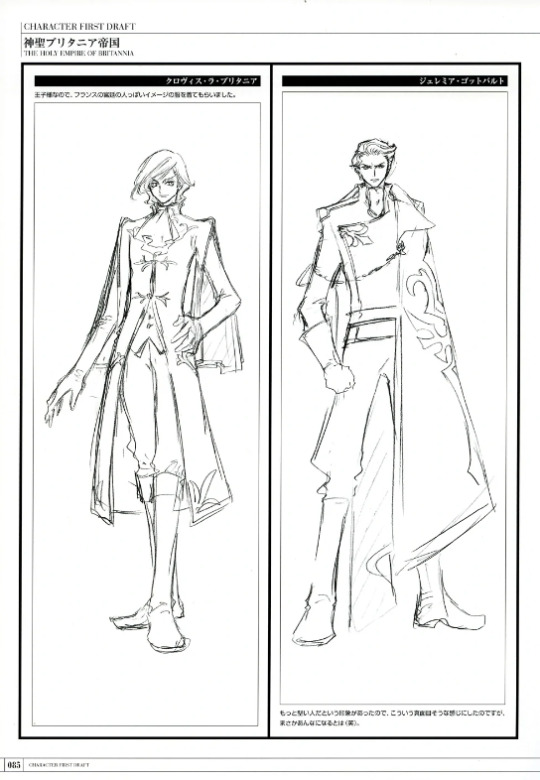
Taniguchi: “If you rewatch the first half of the show after watching episode 23, you might discover new things you didn’t see before.” He refuses to say what these things are, saying that this is an enjoyment exclusive to viewers who noticed themselves. (** He is talking about season 1)
Okouchi was the one who insisted that a mask was necessary in order for it to be a Sunrise anime.
Ookawa : “Director Taniguchi is someone who makes it clear what his likes and dislikes are, and this really helped our work. I like Cornelia, and I hope she can be happy.” (**I’m sure she’ll get along well with Fu-kuyama, that crazy Cornelia fan)
Ookawa seems to be a Lelouch fan. She says that she worries whenever Lelouch does something stupid or uses the Geass in a wasteful manner.
Translation By Celiss Galvea. Hope you enjoyed.
#code geass#original code geass#lelouch vi britannia#lelouch lamperouge#goro taniguchi#clamp#lelouch of the rebellion#character deigns#official material#interview#nanase okhawa#コードギアス#c.c.#cornelia li britannia
21 notes
·
View notes
Text
pluto in aqua (get ready)
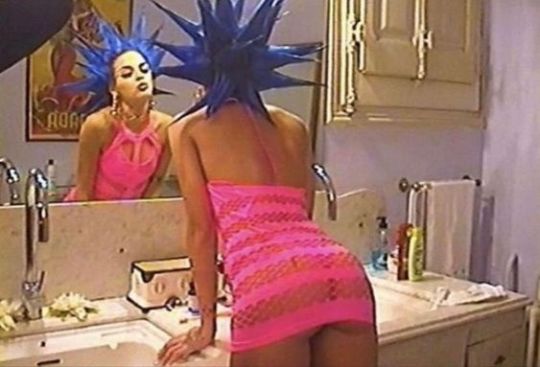
As any kind of creative or owner of media/watcher of culture (all of us), things that went out of style due to digitization are going to come back in a BIG way! What'll be collectively 'in' will be what's unique and what DOESN'T have mass appeal. Anything that becomes big will be organic like how the stars of yesteryear were. But there won't be many of them.
But on the ground:
Magazines that are printed ON DEMAND Indie radio stations that don't play big artists CD players, cassette players, ipods, mp3 players, etc House phones for privacy/landlines Internet forums and blogging
We're going back to what life was like between the late 70s and mid 2000s for about 20 years before truly leaping forward. We'll definitely have a mix of new-age tech but the contrast will be people finding comfort and security in what they can own and control individually.
Going to small shows/gigs to check out new artists will be in Record stores and small niche businesses will blossom Music artists will be encouraged to put their stuff on cds to sell so their fans can own them (and combine it with cute merch) Fan zines will be all the rage
It's the era of the SUPER NICHE.
66 notes
·
View notes
Text
BL doujin & Men Who Make Some of Them
If BL is stories of androphilic men by androphilic women, then what’s the opposite of that? It would probably be stories of androphilic women by androphilic men.
The latter is what Minamoto Kazuki mainly dabbles in.

Apart from straight & BL manga, he also authored Shoujo Manga Artist Minamoto-San Comes Out. Yeah, that’s the title. It is autobiographical if that wasn’t obvious. Arguably, his most famous manga, at least in BL fandom, is Wall Circle's Doujin Artist Nekoyashiki-Kun's Desire for Recognition Grows which got live-action adaptation: KabeKoji in 2022.
Androphilic male characters who create straight content is not rare in BL. In 2023, from what I can recall, we got two such characters: Sung Woo Jae from Individual Circumstances (2023) and Yoh from Taikan Yoho (2023). Jinta from Cherry Magic (2023) also writes (presumably straight) romance. Even before that, we got an entire BL live-action franchise (starting with The Novelist (2018)).
Doujin production and consumption
Doujinshi (doujin for short) is self-published works. It includes both derivative works (fan works) as well as original works. It is estimated that nearly half of the doujin produced and circulated are BL. These are traditionally sold at conventions like Comiket. These days doujin are sold online, for example through dedicated websites like DL site.
Doujinshi culture and Comiket especially has been instrumental in the development of BL as a genre. Unfortunately, unlike other BL pioneers such as Mari Mori (her 1961 novel A Lovers' Forest is considered the first BL) and the Year 24 Group, Meikyu doujin circle (Yoshihiro Yonezawa in particular) seldom find mention in history of BL.
BL doujin grew side by side with commercially published works. The original use of the portmanteau yaoi (no peak, no fall, no meaning) was an indication of plot what plot nature of those doujins that subverted the East Asian narrative structure to focuse exclusively on erotic relations. Doujin BL varied widely in themes and approaches, even more than commercial BL as doujin are not created to appeal to the masses, instead cater to super-specific fandoms. Also, it is easier to debut into doujin arena than to commercial BL. However, since these are literally ‘thin books’ in most cases, there is associated limitation. There is cost of printing to be taken into account as well.
As more explicit doujin (yaoi) and less explicit BL (shonen ai, etc.) coevolved in a porous environment, BL transformed into a successful genre in itself with numerous dedicated magazines and multimedia adaptations. Moreover, doujin was good ground for experimentation and yields in that arena made its way into mainstream BL and enriched it.
Commercial BL welcomed many doujinshika into its fold. e.g. Ayano Yamane (author of the Finder series) is associated with a bunch of doujin circles at different points in time: GUN MANIA, Shouhoku Taiiku Yougushitsu and Ouka Seisaku.
BL mangaka continued producing both doujin and commercial BL. e.g. Kizu Natsuki (author of Given) is a prolific doujinshika under the name Gusari in Sashikizu circle.
BL mangaka produced doujin of their own work. e.g. Ichikawa Kei (author of Blue Sky Complex) published erotic extras as doujin.
These days, there is pixiv among others and long serialization possibilities. Authors are less constrained by space – unlike physical publication, web publication is not constrained by real estate (number of pages, chapters, etc.). Thanks to the internet, the distance between doujin and commercial BL have shortened.
A lot of gei comi (bara) is also self-published.
Doujin BL culture exists everywhere BL is famous with wide variation.
Doujin played an important role in emergence and growth of Korean BL. e.g. Totally Captivated by Yoo Ha Jin had doujin extras.
Chinese doujin culture is slightly different from that in other countries. Note-worthy is the self-publication of danmei (Chinese BL) novels. Three most recent cases against danmei authors [and their accomplices including those who helped the authors print, bind, package and sell those copies] were for self-publication.
天一(Tian Yi) for her student X teacher SM erotica 攻占 (Seize Control) - charged for self-publication and violation of law prohibiting publication of obscenity [explicit SM involving a 17-year-old student and his teacher in the novel]
深海先生 (Mr. Deep Sea) for her historical romance 锁帝翎 (aka 笼中帝 ; The Caged Emperor) - charged for self-publication.
There is a third. But the details are not available in the public domain.
It used to be a common practice for authors to self-publish uncensored versions of their web-published works, sometimes with explicit extras. These were intended for fans who wanted to collect these copies and to express their appreciation to the authors. Both self-publishing and “obscene content” are illegal in China.
Doujin, BL and their creators
Kabe Koji is the journey of a doujinshika, Mamoru Nekoyashiki, who yearns to be recognized as such and also as a beloved. While in high school, he fell in love with his childhood friend Kazama Issei whom he is sure doesn’t like him like that, thanks to rampant compulsory heterosexuality. Being gay was something he felt he had to keep under wraps not only because of fear of rejection but also because of heterosexism. Talented in drawing, he visits Comic King, a popular otaku convention where he discovers a different world – where male androphilia is celebrated in art.
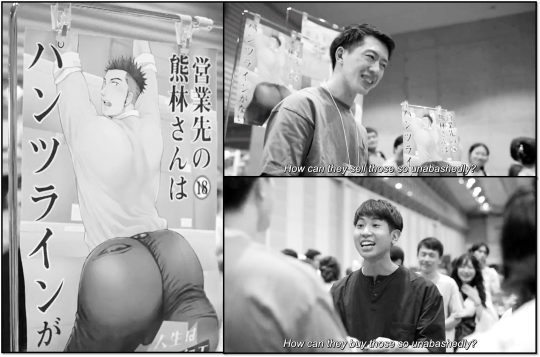
This inspires him to cultivate his talent in drawing and to pursue a career in manga. Since the art he was most drawn in by was ero-manga with macho uke with bitch characteristics, that’s the style he pursues.
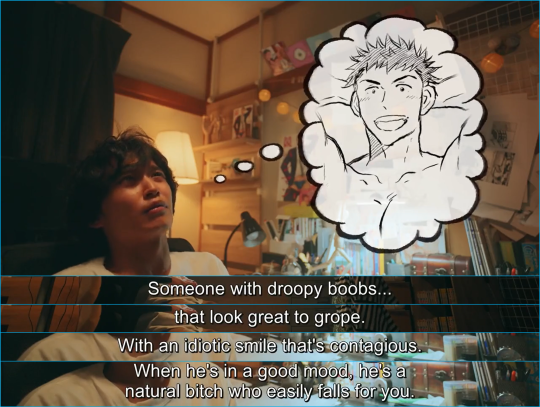
When we meet him, this is the subgenre that we see him focusing on. His influences are pretty obvious.
Moreover, the main character (hence the target of affection in his work) looks a bit like his crush. Issei notices this and tries to draw himself like that (with disproportionately thin neck) in little notes and letters to his Mamocchi.
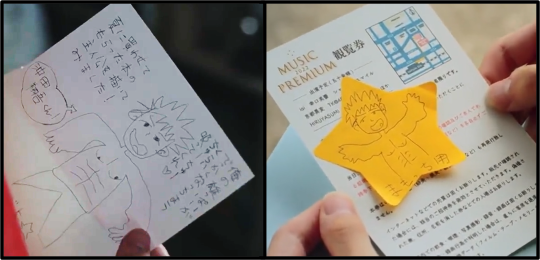
[I honestly think Nakao Masaki was bit of a miscast for this role appearance-wise because in the manga Issei is more on the gacchiri (muscular) side of ikemen. Whoever thought Torii-san’s uke from Fudanshi Bartender no Tashinami (2022) would be right fit for Issei’s character. The actor clearly didn’t disappoint in any other aspect. This is like the case with casting decision in One Room Angel (2023) wherein a manga character with gachimuchi aesthetics was changed into a lean ikemen. An opportunity for a different body-type was wasted. No complains against those actors since they aren’t the ones responsible for casting.] This is an erroneous assessment. Thank you @tompetertrash for correcting me.
Nekoyashiki, while pursuing training and education in manga making, has already established himself as a fairly successful doujinshika known as Honeniku-sensei of Muscle Department Store. He belongs to the Wall Circle.
"Kabe circle" (wall circle) — a slang term for doujin groups or "circles" that are popular enough for their booths to be placed beside the wall of the convention, for ease of line management. (Source: ANN)
He is friends with Yamada, a fujoshi who is his support in creating, defending and selling doujin.
Such friendships are not too rare. For example, friendship between Yoh and Manju in Taikan Yoho (2023). And the IRL friendship between female danmei author Lan Lin and male manhuajia Liang Azha.
Yun SuAn's friend Choi is a BL manhwaga in My Damn Business (2024).
Nekoyashiki meets two other characters at Comic King: Framboise and Takkun.
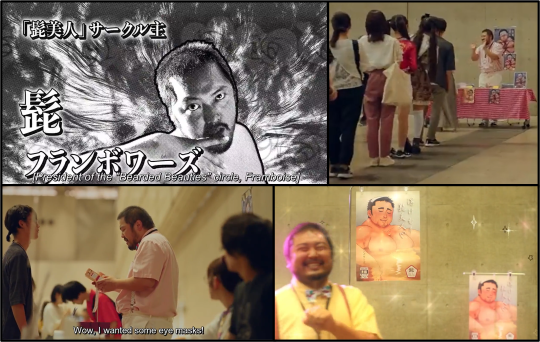
Framboise is the president of a doujin circle called Bearded Beauties. He is very popular. He is not only among the wall circles each time we see him, but also is showered with gifts by his fans. He acknowledges that he has been doujinshika for years. His art resembles him – body-type, facial hair, moe. He keeps inviting Nekoyashiki warmly to a gathering of muscle BL artists despite getting turned down. His interactions with Nekoyashiki are precious.
Takkun is Nekoyashiki’s fan. He is inspired by Nekoyashiki and worked hard to establish himself as a wall circle doujinshika.
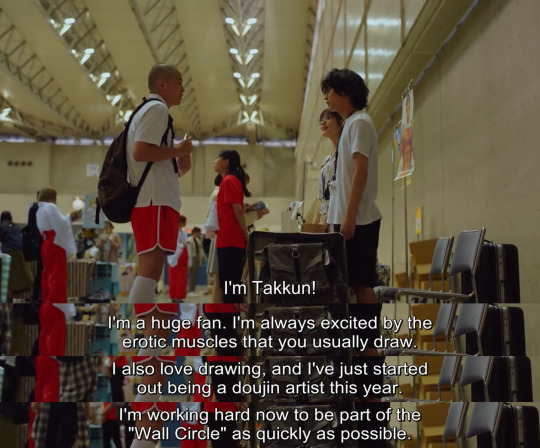
His rise from a consumer to producer of doujin and finally a wall circle doujinshika mirror's Nekoyashiki’s journey. Moreover, his rise is contrasted with Nekoyashiki’s fall.
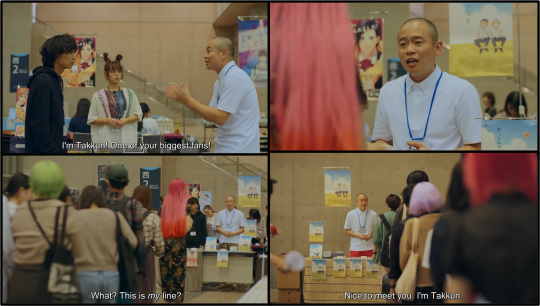
Also, one of two characters on his doujin cover looks a lot like him.

Unlike Framboise and Takkun who draw what they like, Nekoyashiki draws to be recognized.
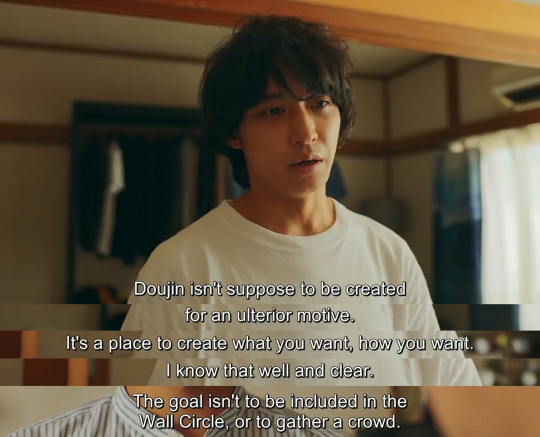
Nekoyashiki draws a second season to his previous work Please Suck on my Enormous, Manly Tits. Despite Yamada’s best hopes, it is not popular at all and loses Nekoyashiki his position as a wall circle doujinshika. He bids goodbye to Suck My Manly Tits series and to ero-manga sub-genre in general.
In a desperate attempt to climb back into popularity, he tries classic BL pairing. We get to see him reading commercial BL as a part of his research. This is an obvious mistake. Yamada wants to intervene but hesitates and ultimately gives up.
When his next doujin, My Perfect Boss Became My Perfect Spouse, also flops, he loses his resolve to be a mangaka.
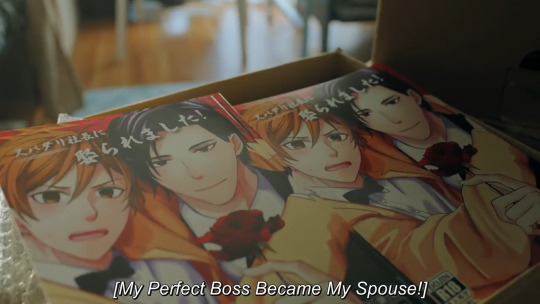
Yamada asks Nekoyashiki to be more honest and expressive in his creation.
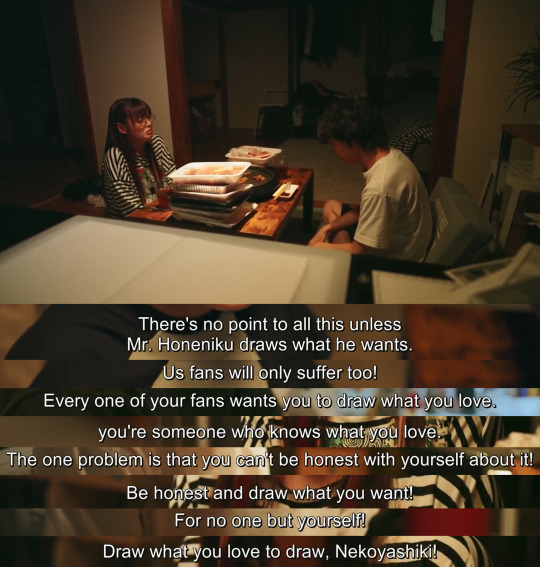
In the end, Nekoyashiki creates a doujin inspired by his own relationship and aspirations – a work that, Framboise and Yamada notices, is to Nekoyashiki’s satisfaction.
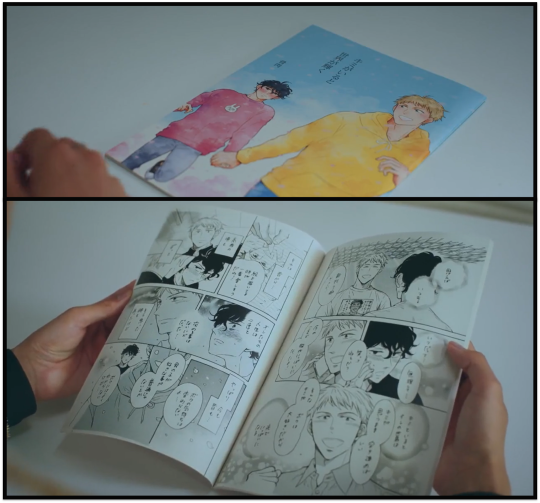
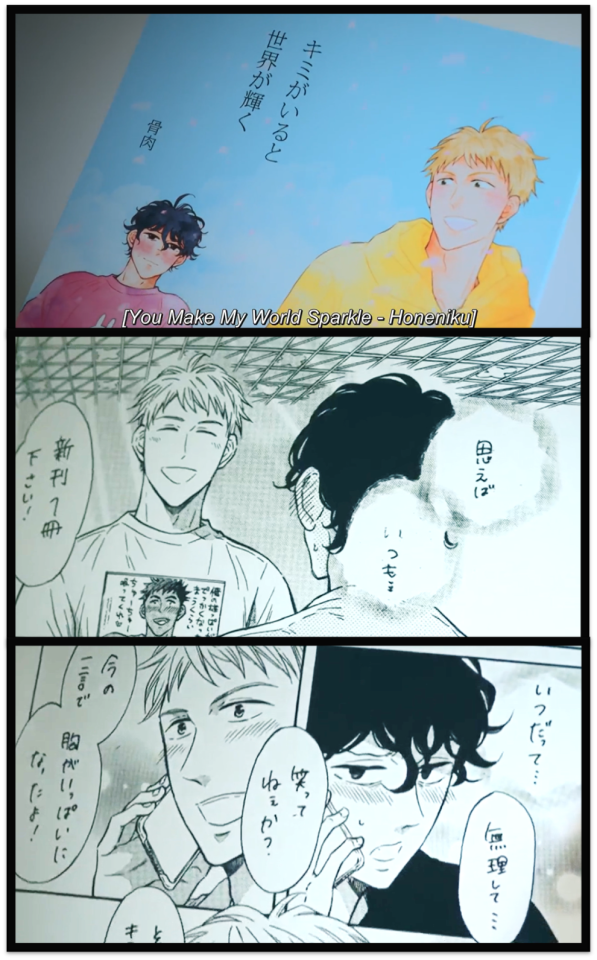
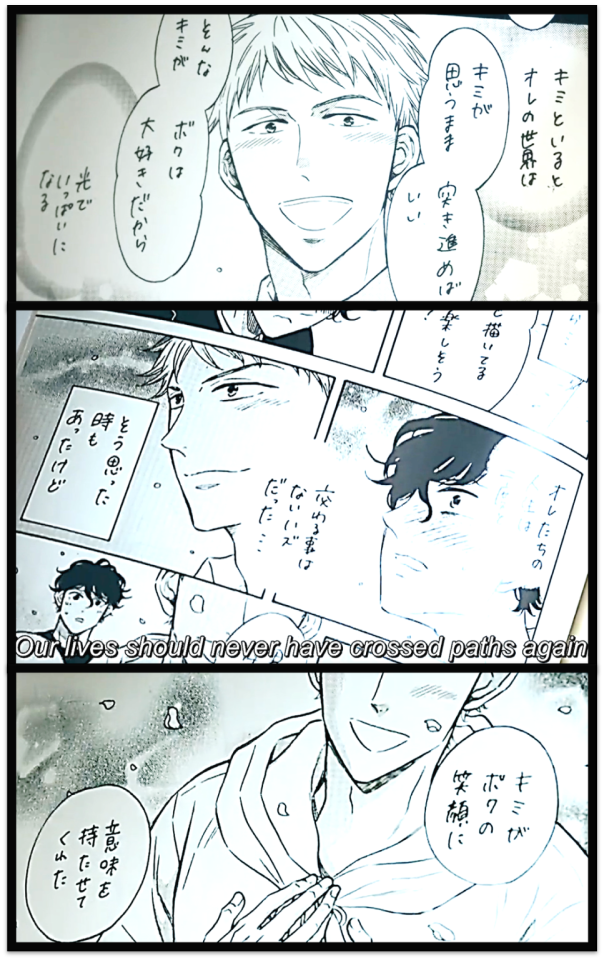
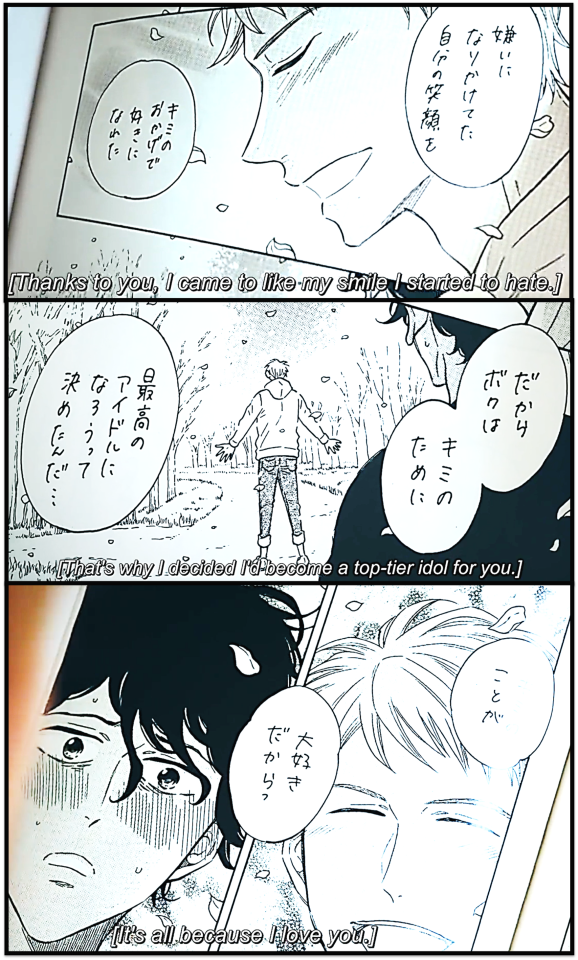
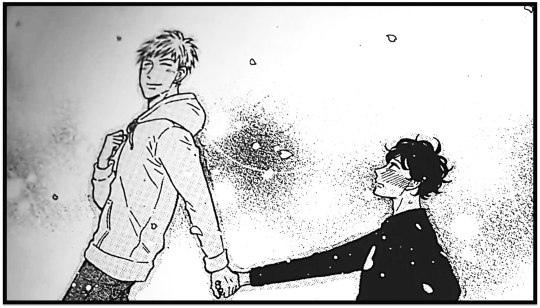
It is common for at least some characters by male BL and gei comi mangakas (who have revealed themselves) to look at least a little bit like themselves. To see examples, check out the beginning of Massive: Gay Erotic Manga and the Men Who Make It where representative art and artists are placed side by side. Some even acknowledge this. e.g. Chinese BL manhuajia Liang Azha once commented on how his shou (uke) tend to look like him as he is today and his gong (seme) resemble his looks from his college days. Moreover, art tend to inspire clothing, haircuts, and other features which in turn inspire art. The influence Tom of Finland had on androphilic men of his days and they on him is discussed in his 2017 biopic. Similarly, mangakas are influenced by their senpais in the field and sometimes it is noticeable in their art too. e.g. Gengoroh Tagame’s historical works looks quite a bit like those of Go Mishima.
Other BL doujinshika in Live-action BL
Yoh from Taikan Yoho (2023) creates his first BL doujin, inspired by his ikemen boyfriend and their relationship, in collaboration with his mangaka friend Manju after his career as commercial mangaka of straight ero-manga takes a nose-dive.
BL Metamorphosis (2022) depicted the process of BL doujin creation in detail as the main character, Sayama Urara, embarks on that journey. Her friends offer her support, especially Ichinoi Yuki who funds the printing and binding. Sayama Urara doesn’t debut as doujinshika as she doesn’t set up her booth at the convention. However, one of the copies lands in the hand of one of her favorite authors Komeda Yu whose commercial BL work Kimi no Koto dake Miteitai was what brought Sayama Urara and Ichinoi Yuki together.
Komeda Yu on the other hand is a doujinshika turned commercial BL mangaka. She visits the convention in hopes of overcoming writer’s block and to rediscover her passion for drawing. She is motivated by the doujin that Sayama Urara created and emerges out of slump to continue with her series.
Fudanshi Bartender no Tashinami (2022) revolves around Soichiro Hibiki, a fudanshi bartender moonlighting as a BL doujinshika, who draws inspiration from his customers and fellow bar staff to fuel his passion.
Minamoto Kazuki
While narrative drives home the point that the various pieces of art we see are works of respective doujinshika characters through haircuts and body types, the fact remains that most of those are actual doujin by Minamoto Kazuki aka MELU. He belongs to the circle: GOOD BYE LIFE.
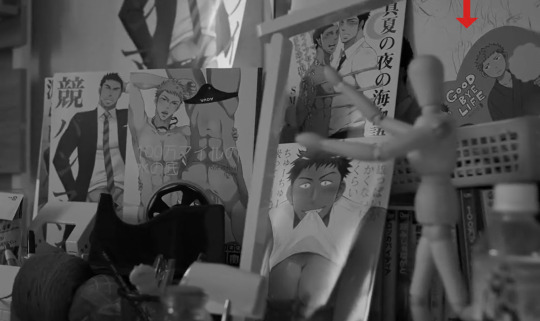
In case anyone want to read them, here are the links:
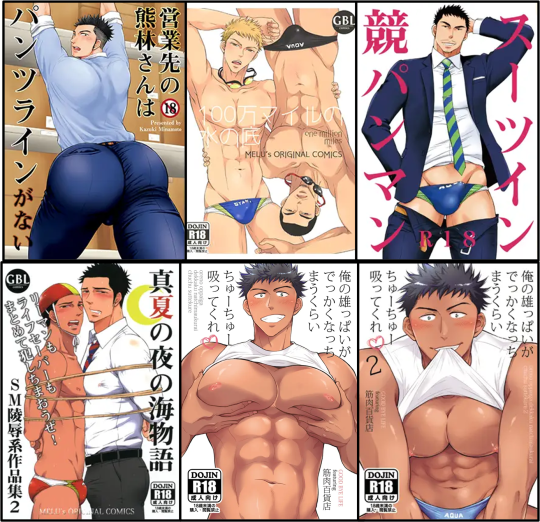
Kumabayashi at Work Has Not Underwear Line
One Million Miles: The Complete Collection
Competition Swimming Brief in Suit Man
A Midsummer Night's Beach Story: SM Assault Works 2
Suck My Manly Tits manga: 俺の雄っぱいがでっかくなっちまうくらいちゅーちゅー吸ってくれ
俺の雄っぱいがでっかくなっちまうくらいちゅーちゅー吸ってくれ2
"Suck My Manly Tits" doujin is in its 3rd season: 俺の雄っぱいがでっかくなっちまうくらいちゅーちゅー吸ってくれ3
Autobiographical pieces that didn't figure prominently:
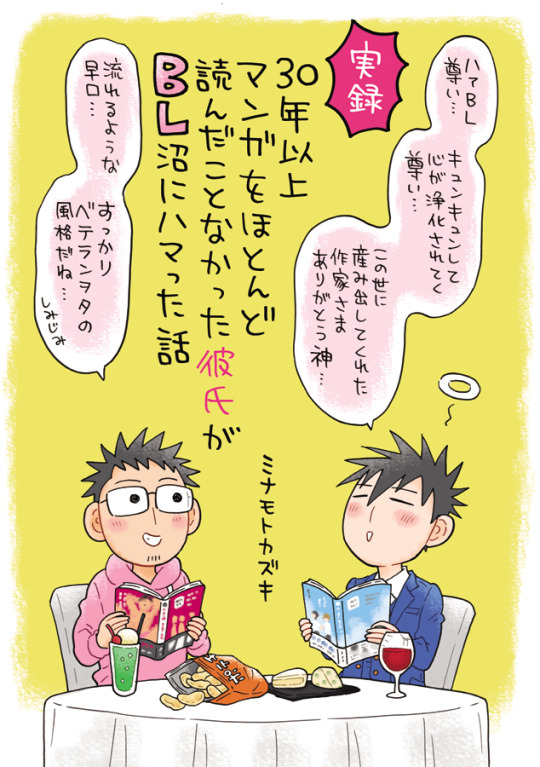
30年以上マンガをほとんど読んだことなかった彼氏がBL沼にハマった話 (A story about how my boyfriend, who has barely read manga for over 30 years, got addicted to BL swamp.)
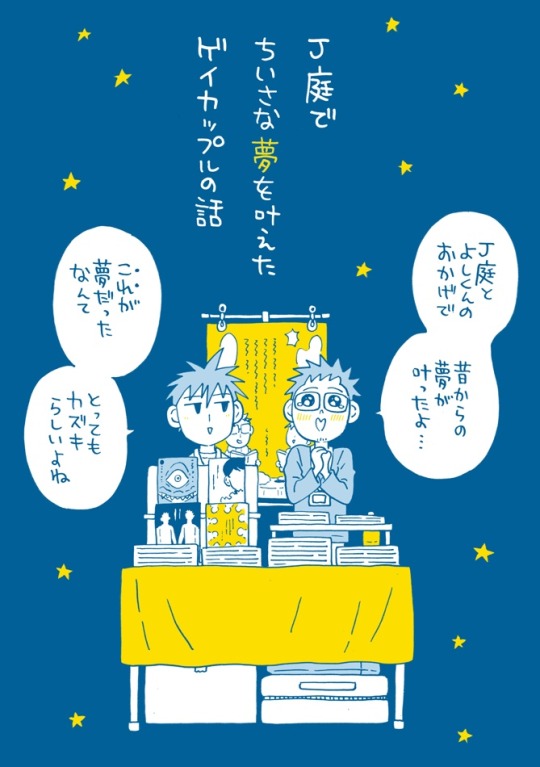
J庭でちいさな夢を叶えたゲイカップルの話 : Story of a gay mangaka and his boyfriend who participated in J.GARDEN, and their little dream that came true.
The cover of this doujin got live-action adaptation in one scene that one would miss if not looking closely:
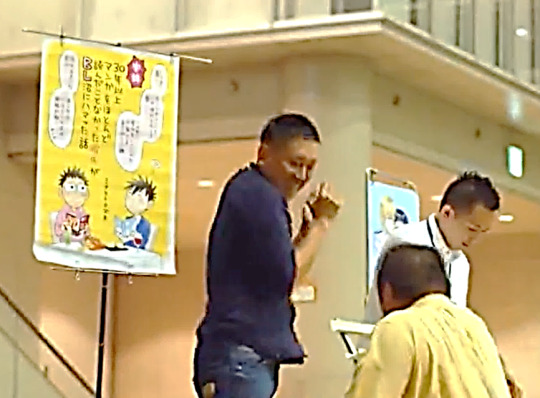
Other interesting works by Minamoto Kazuki
Autobiographical: Shōjo Mangaka no Minamoto-san ga Kaminguauto Shimasu.
2. Those with English translation:
The Midnight Association for The Broken Hearted
The salaryman who has a fetish for suit gets horny.
The Gay Who Turned Kaiju
3. Essay-manga about doujin-making
夜寝てる間にBL原稿のお手伝いをしてくれる妖精さんがいた話
BL同人原稿(アナログ18禁!!)を東京から大阪の印刷所まで届けてくれた彼氏の話
4. About Kabe Koji (2022) live-action:
自分が原作の実写ドラマの大ファンになってしまったので原作者自らヲタ活をしています。
自分が原作の実写BLドラマをリアタイしたくて大阪へ行ってきました。
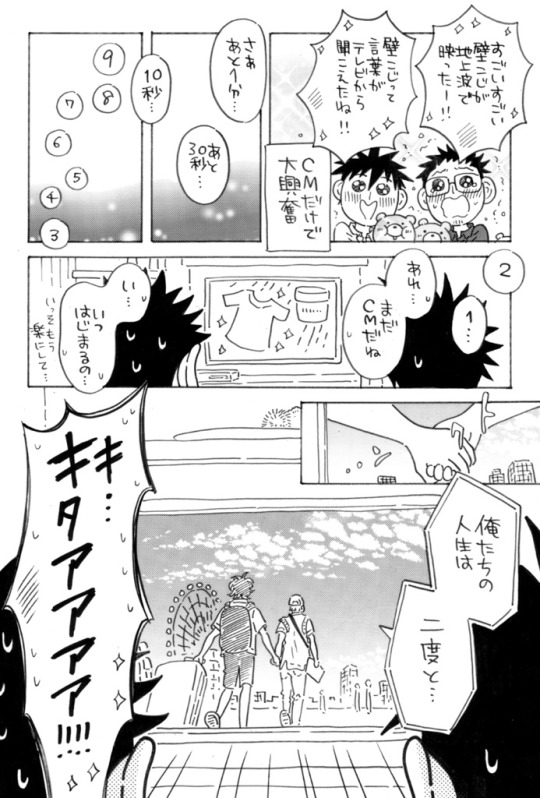
___
This is dedicated to @bengiyo and @liyazaki for gifs featuring Framboise. Thank you very much. While I was trying my hand at a review for One Room Angel (2023) and wanted to express my disappointment at the lean ikemen casting for Kouki’s role, I got an opportunity to use those gifs. I really wish someone would create some gifs for SHIMBASHI TUGBOAT content too.
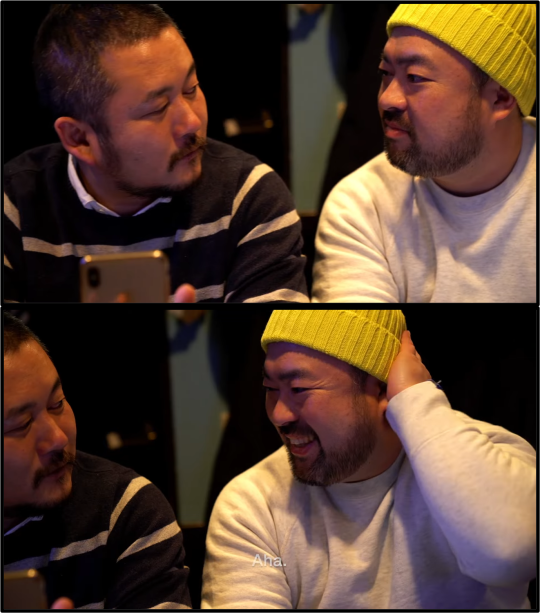
(Especially this scene.)
For someone who is as much a fan of “tribes” as BenZi, I would not mind playing the 9Monster live-action BL bingo version.
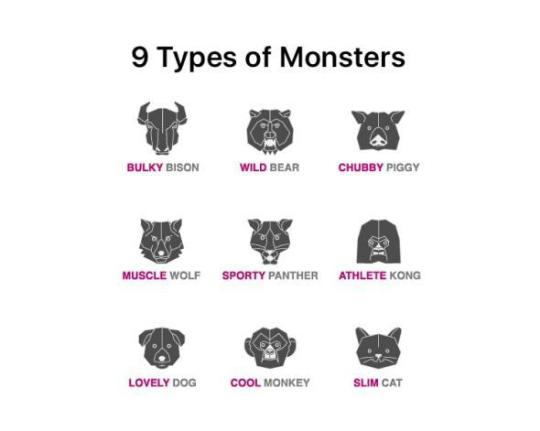
113 notes
·
View notes
Text
hello and welcome to my chappell roan ted talk
these days, more than ever, i am feeling incredibly disheartened by the treatment of female artists and the deep societal misogyny that it signifies. there is such a vast expanse between this and the typical experience of a male artists, that they have come to occupy an entirely different space in the cultural zeitgeist. male artists are often considered evergreen. allowed to make mistakes, to be rude, to release below average material and be given endless chances, to age, and to have problematic pasts and relationships. (yes, i am generalizing, of course male artists experience mistreatment as well, but generally to a lesser, and less permanent degree. we are talking about women today.)
the experience of a female artist is that of being constantly balanced on a knife’s edge. they are idolized, deified and built up to insanely lofty heights, then one (real or perceived) wrong move and they are viciously turned upon. they are built up almost solely so that they can be delicious to destroy.
we’ve seen this over and over in the past with people like taylor swift, demi lovato, britney spears, katy perry, kristen stewart, miley cyrus, ariana grande etc. (blake lively is a current example.) once they reach a level of overexposure and mass appeal, the vultures begin circling. one bad song, or thoughtless remark, or bad breakup, and they are public enemy #1. even when they do something truly problematic they are not allowed to learn and grow from it as men are. their purpose in society is immediately shifted from entertainment at their charm and success to entertainment at their suffering and demise.
this phenomenon used to be mainly sourced at the hands of media figures. journalists, talk show hosts, gossip sites, magazines. this highly visible upper echelon held all the cards and could sway the public in any direction they pleased in a pre internet monoculture, but now, with the rise of social media, billions of normal people have this power while being safely guarded behind a screen, or even wholly anonymous.
the recent years (and impact of younger generations growing up chronically online) have led to a sort of moral grandstanding, virtue signalling, victorianesque societal revolution. in this space there is no room for error. everything female artists do is taken out of context, twisted, and shamed. they are fully dehumanized and treated like a product belonging to the masses. a subject of discourse more than a person. they are expected to be perfect in every aspect, off the bat, with no room to make mistakes or learn. they need to be knowledgeable in every subject and never ever offend anyone, or do anything to bring anyone, anywhere, anything less than pure satisfaction.
there is no right move a female artist can make. if they take chances to further their career they are calculated, selfish, greedy, competitive. if they are content with the level of success they are at they are lazy, mid, a flop. if they are comfortable with their appearance and body size and aging, they are mediocre, not meant to be famous, a bad influence. but if they alter their appearance in any way they are fake, self obsessed, arrogant, and a bad influence. if they appear perfect, well spoken, kind, and generous then they are liars, manipulators, schemers. but if they appear blunt and not perfectly media trained then they are not cut out for fame, ungrateful, annoying, and spoiled.
( i am aware that i sound like the barbie movie monologue, but that doesn’t change the reality.)
the thing is, there have always been haters, trolls, liars who wanted to instigate the downfall of female celebrities. who couldn’t bear their success and admiration, and just wanted to burn it all to the ground. but today, in this social media generation, the call is often coming from inside the house. so often the ones to turn on famous women and treat them inhumanly, are their own supposed fans. people who are so obsessed with this perfect image that they project onto their fave. who feel so deeply entitled to their time, attention, and recognition that they feel personally slightly and attacked when things don’t go the exact way they want.
let’s take for example, the cancelling of taylor swift’s vienna tour dates.
these shows were cancelled by the venue management, due to a planned terrorist attack that was intended to kill 10s of thousands to 100s of thousands of people. due to the delicacy and danger of this whole situation, taylor swift decided to not mention the incident until after she had finished her european dates and was safely back in the US, as to not further endanger herself, her crew, and her fans.
this caused an unbelievable outrage. people who were both personally affected by the cancellations and those who weren’t, came for her throat. they were furious at her for not talking about it. for not coddling them and telling them how deeply sorry she was. for not grovelling at their feet and self flagellating to make it up to them. once she was back in the states she did in fact release a statement telling everyone how devastated she was over the whole experience and explaining how she felt it was important to stay silent until the right moment to speak on it.
now you’d think this would be enough to assuage the angry mob, but no. they doubled down and declared that it was too little too late, not enough remorse, and that they deserved even more of her attention and repentance. the whole behavior reeked of a desire to chain her to a post and throw bricks until she promises to do better next time and to give everyone their own personal concert and cradle them in her loving motherly arms, to make amends.
and these are supposed to be her FANS. people who were willing to spend hundreds, if not thousands of dollars just to be in the same room as her. just to breathe her air.
now, taylor swift ultimately will be fine (i am talking career wise), she is one of the richest female celebrities in the world. no one can even come close to matching her music sales, fan base, legacy, and broken records. she can lose 10%, 20% of her fan base and still be on top of the world.
but now let’s look at chappell roan.
in the past 6 months or so chappell has rocketed to fame. as someone who has been a fan for ages, this explosion of recognition and admiration was both outstanding to witness, and deeply dread inducing. especially knowing that chappell stands out as a loudly queer artist, who is unique and deeply talented, who is open about her struggle with bipolar disorder and depression, and has no desire to whittle herself down for public consumption. all of this, while incredible and refreshing, was a clear warning sign for what was to come, given the history of female artist reception, even for those who check every box of being publically consumable.
in the past couple weeks there has been a massive wave of both “fans” and those who didn’t even know chappell previously, turning against her for sport. chappell roan released a statement after having nonconsensual interactions with crazed fans, having her family members stalked and doxxed, being yelled at and harassed on the street, and having her personal history, relationships, and childhood mined for exploitative content.
now this behavior may sound familiar. just the typical feral stan behavior that celebs often experience.
but one key factor here is that chappell is brand new to this level of exposure. her fame exploded before her income could from this success, far too suddenly to have taylor swift level security measures set in place around herself and the ones she loves. too sudden for anyone to adapt to their experience of existing in public, online, and even private spaces being permanently altered. she woke up to an entirely new world and had little time to figure out how to move within it without further damaging her own mental health and safety, and likely few people around her who had experienced even close to this caliber of success and could guide her through it. all with no major record label crafting her image or providing pr.
so, the statement. chappell has recently gone on social media and set boundaries for herself. for how she chooses to move within this new world. she has explained the way this rise to fame has impacted her mental health and filled her life with fear and anxiety. she has made her position clear that she is an artist professionally, but a human being when she’s off the clock. her career is just that, a job. an amazing job, yes, but she is still an autonomous person who is allowed to clock out. who is allowed to turn off the character that she puts on for performances, and be left alone when she is not at work.
this includes, (considered most egregious) fans not touching her without permission, coming up to her in public and asking for pictures or autographs, or shouting her legal name at her on the street and taking pictures of her. as well as not harassing the people in her life or sharing her personal information online.
now while these things all sound reasonable, and something any one of us regular folk would expect in our daily lives, this boundary setting is nearly unprecedented for female artists. anyone who has tried has been deemed a cultural blight.
celebrity worship and stan behaviour has lead to an extremely parasocial society.
fans feel it is their god given right to own every aspect of a celebrity. they “deserve” to know every detail of their relationships, their thoughts on politics and events, their secrets and shames and preferences and loves and traumas. they are “entitled” to their time, attention, and endless gratitude, no matter what they are going through or willing to offer up. female celebrities are solely there for the consumption of the general public, they are to be picked apart and chewed up strip by strip. fans “deserve” to touch them, take pictures of them, yell at them, just for a moment of recognition, validation of their obsession, a glimpse of heaven at the alter of their deity. this is just the way it is, has always been, and will always be.
but chappell roan has said NO. no, this is not the way it has to be. just because something has been tolerated in the past, doesn’t mean it’s not wrong. doesn’t mean the future generations need to abide by the tradition of stalking, harassing, and devouring. doesn’t mean that it should be the norm to accept the potential of home invasions, hacking, and assassination attempts.
this simple act of boundary setting has caused an absolute outrage. media publications, other artists, “fans”, haters, and causal media consumers have come with pitchforks and torches to burn her at the stake. they say she is entitled and ungrateful, despite her explaining how deeply grateful she is to all those who support her and also support her privacy. they say she is a nobody and hasn’t earned the right to set boundaries. that society needs to swish her like wine in their mouths and spit her out once they’ve tasted enough, before she’s allowed to say anything other than “thank you thank you i love you i am not worthy”. they say she is not cut out for fame, because this is what fame is and has to be for all female celebrities. they do not get to have autonomy or choice. how absurd that they’d even try, how selfish and greedy and self important to think they deserve it??
of course true fans are going to rock with her no matter what, but chappell is brand new to most. to outsiders she is a face that appeared one day already cemented in a superstar position, and was suddenly unavoidable, confusing, and suspicious. the court of public opinion and the power of negative discourse have a weight to them which can easily overshadow the newfound success of a niche, less easily marketable celebrity like chappell, who has only just gotten her foot in the door.
in the midst of this discourse something else has occurred to deepen the gash of public animosity. chappell roan was given the career and life changing opportunity to perform at the VMAs for millions of people. an opportunity to grow her critical notoriety and fan base, as well as bring queer representation to the live screen, that would be a massive career misstep to pass up on. in accepting this opportunity, chappell was forced to cancel a couple shows that had been planned for a while. she tried to make the situation work for everyone, but ultimately was unable to. she expressed her regret and apologies and assured everyone that she would be rescheduling those shows when she had the chance.
as we have seen with the taylor swift vienna situation, this was NOT going to go down well.
“fans” came after her with a vengeance. they called her selfish, greedy, fake, and wicked for choosing her career growth over their personal experiences. said she was an ungrateful hypocrite for asking the world for space and then choosing the option to be unhumble and promote herself to the masses. the tickets were refunded, but people had CHOSEN to book hotels and fly out to see her in concert and thus blamed her for their financial burden. just as taylor swift “fans” did with the vienna tour dates.
as if chappell roan should be obligated to recoup them for the financial choices they made, and give them the experience they wanted right the fuck now, with the right level of humility, or else be deserving of punishment.
it is understandable for fans to be disappointed that they didn’t receive the experience they hoped for. that the situation was so sticky and immediate that they didn’t have time to cancel plans and grieve the loss. i know when i waited two hours after the opener at sabrina carpenter’s tour last year, just to find out she wasn’t able to perform due to bomb threats, i was heartbroken and angry at the world. i was frustrated with how the situation was handled by management, but i was not angry AT sabrina. i didn’t evicerate her online and demand that she FIX my heartbreak at once. i sat with my feelings and knew that there would be other opportunities, and that
sometimes life isn’t gratifying, no matter how fucking unfair it feels.
it is becoming more and more rare for any degree of understanding and grace to be given to female artists. every success i witness for the artists i appreciate (like this year for sabrina and chappell) fills me with a deep foreboding dread. because they are considered disposable and easily replaceable in this instant gratification, tiktok algorithm generation. everything has to be right now, done perfectly, and hold up to high moral inspection or else they are slotted for obscurity or public crucifixtion.
meanwhile, every aspect of these situations is deemed frivolous by society. they say if you don’t like it, get out and go work at dairy queen, there’s a line waiting behind you who are willing to appease us more. they say that having income from success immediately delegitimizes any social commentary or personal issues. because celebrities are not human beings. they are religious figures. they are both royalty and court jesters. they are toys to be played with ad nauseam, and then discarded.
but why?
why does it have to be this way? why does wanting to share your art with the world mean giving up your safety, privacy, and peace? why is it okay for male celebs to be grumpy and brash and never interact with fans, but it is a cardinal sin for female celebs to do the same or to transparently ask for it? and why is any of this important to you and i, who are barely scraping by and unlikely to ever be famous? why does it matter when these women generally still have some semblance of their careers leftover even after mass disdain?
because all of this is indicative of a greater issue that pervades every aspect of society. it is simply that with famous people we can see it on a macro scale.
all women and femme presenting people are held to the same standard as female celebrities, but on a less publicly visible level. in our careers, our relationships, our expressions of joy, our community and bonds with other women, and our own calcified internal misogyny.
we are here for consumption, we are here for the pleasure and entertainment of others. how dare we ask for more? how dare we know our power and set boundaries for ourselves? how dare we think we deserve a seat at the table, even as we age and grow and expand beyond the bounds of charming ingénue? how dare we collaborate instead of seeing each other as competitors and threats to our own power and beauty and ability to be loved?
how fucking DARE we ever get the idea that we are worth more than our youth and beauty and service to others?
i don’t know how we, as a whole, address any of this when the matter at hand is so deeply pervasive and engrained in the foundation of society. but i, for one, will start by looking at my own role in the treatment of female artists.
i will take the time to ask myself why even the existence of certain figures sparks a feeling of rage within me, and why i feel such a deep desire to know every detail, action, and thought of the artists i appreciate. why i feel joy and satisfaction when female artists i dislike are taken down, or “beat” by someone i prefer. why i let drama that has nothing to do with me alter my perception of art created by people i do not know personally. why my black and white thinking and sense of justice only applies to those who don’t resonate with me on an artistic or personal level.
i will work on finding grace and understanding for those who are trying to grow beyond their mistakes and be better people, the way that i am trying to everyday. those who exist both in the public sphere and in my daily life.
because it’s never too late to rip out the teeth of the bear trap we were born in.
long story short: chappell roan did nothing wrong. but if she ever truly does, all you can do is ask for accountability, then take a breath, get the fuck over it, and see the bigger picture for once
thank you for coming to my ted talk
#enjoy my ramblings i will not be rereading or editing anything i wrote#chappell roan#taylor swift#taylor swift vienna#stan culture#celebrity worship#chappell did nothing wrong#fight me#i do not care if i sound sanctimonious. i am pissed#can you tell i’m on a new adhd medication#no one’s gonna read all this but you should tho
26 notes
·
View notes
Text
I finished Pet Shop of Horrors: Tokyo, and I have some mixed feelings about it as a sequel.
On one hand, it was a lot of fun! I genuinely adore the choice to set it in Kabukicho and have Count D start befriending all the local queer people. I really enjoyed leaning a bit into D's cuter, goofier side, as well as his more benevolent and helpful side. Him running around giving magic pregnancy eggs to lesbian couples and having tea with drag queens is 10/10. Him clowning on Lau Wufei constantly is also 10/10. And I really don't mind that the series went in a more non-horror direction, as I really can see the appeal of that from a characterization perspective. Count D deciding to use his insight (and pets) to prod people in harrowing but helpful ways instead of just setting them up for Thematically Appropriate Death/Misery most of the time like he did in the pre-Leon-and-Chris days is a really interesting choice for him to make.
Also, some of the chapters were genuinely quite good as standalone stories! I loved Deathtrap, Decadence, and Dispatch, just to name a few. And the sphynx cat guy!! The sphynx cat guy is the pet of all time tbh.
All in all, I had a pretty good time reading Tokyo! If nothing else, I was quite consistently delighted by D, and most of the individual chapters' stories were compelling (though a few of the ~animals all along~ twists felt rather forced or contrived).
On the other hand, Tokyo did feel like it was missing big parts of the appeal of the original Pet Shop of Horrors. Some of what I loved about the original, murders or no, just wasn't in there.
To start with, I feel like Count D somehow managed to lose a big chunk of his depth from the original series. His family is barely mentioned at all! I can remember one brief reference to his father (and his father's death), and his grandfather comes up relatively rarely as well (mostly just to hammer home why Lau Wufei can't kick D out of his building). And that's wild! Because D's relationship to his family and his family's purpose was a big underlying part of his character in the original. Even in early chapters when we knew nothing about what the Ds were or how their Whole Thing worked, the manga made that familial element feel ominous and important. But now it's all out in the open, now the audience knows what D is and how his family works, and the thread just. gets dropped.
How does D feel about the death of his father? How does he feel about knowing that his grandfather was secretly observing him the whole time he was in L.A. (and possibly for a long time before then)? Is he still in contact with his grandfather while in Tokyo? How is their relationship now? How does he feel about knowing that his grandfather is raising his new brother/son/reborn dad/whatever the hell you want to call the new D? I get that this is a new series in a new magazine, so D's feelings about the original series were never going to be the centerpoint, but leaving out his connection to these events entirely just feels like SUCH a glaring omission. And if he's purposely avoiding thinking about these things, then show us that!
And as an expansion of that, what about the whole revenge mission D is supposed to be carrying out? In the original series, D dreams of extinct animals and wakes up crying. Masses of animals dying on the other side of the world in a wildfire gives him nightmares and makes him feel like he can hear their screams. He nearly collapses and gives everything up while he's on the run close to the end, but he has a vision that prevents him from doing so. His family's purpose isn't just something pushed on him by his grandfather—it's something he is constantly haunted by. The Ds are not allowed to forget the suffering that drives them.
So like, I am absolutely down for a D that chooses to embrace some small measure of hope and move away from a search for vengeance. I love that, actually. I think it's a great way to show the impact Leon and Chris have on him. But Tokyo gives us absolutely nothing in terms of D actually making and dealing with the fallout of that choice. We see him seeking to help out and protect endangered native species, and he's generally compelled by sole survivors and dying embers of every kind, but that's really all we get from this angle of him.
How does D deal with the pain and sadness and anger that runs in his veins? Does he struggle to justify his shift in methods? Both to his grandfather (if they're talking) and to himself? Does he struggle to reconcile his fondness for individual people and his hope for a redeemed humanity with the continuing degradation of the natural world throughout the 2000s? Does he view himself as a helper of humanity now? Human-neutral? Does he see himself as a guide? It's almost impossible to say, because PSoH: Tokyo just does not tell us.
The suffering of the whole natural world runs in D's blood, and D in the original absolutely does struggle to reconcile that fact with his growing care for humanity and humans. He's still conflicted even at the very end, loving Leon enough to let him onto the ship for a moment, but knowing despite the tears he sheds that he cannot let him stay. But Tokyo!D seems like that contradiction has just ceased to be a problem for him. If he's learned to set aside the fear and pain and rage that runs in his blood, it would be nice to see that development. If he feels he's somehow doing right by his mission as he helps the human and animal denizens of Kabukicho, it would be nice to see that justification.
Overall, in Tokyo, D just never seems to struggle with anything. He seems to have no real problems! He's rarely upset, especially late in the series. He has no difficulties bigger than "can't find a kappa when he wants to" or "passes out after Lau Wufei makes him do too many blood tests." I do really enjoy D's sillier side, and I'm happy to see a version of him that seems happier overall, but taking away all of his struggles just makes him feel like he's had all of his depth sucked out.
The original PSoH has whole chapters where D himself is the "victim" of the supernatural happening of the week (the orangutan in Donor, and to an extent the mermaid in Deep and reincarnation in Dynasty). In particular, though Donor has a tie-in plot for Leon, the chapter's story and themes ultimately all center around D and his painful relationship with his family. Dynasty centers on the Counts' disconnect from humanity and our D's emotional struggle to deal with that despite caring for people more than his ancestors did. Can you imagine getting a chapter like that in Tokyo? A whole chapter about inflicting D with complicated emotions, about making him feel yearning, regret, and grief? There's just nothing like that.
There's the very occasional moment in Tokyo that hints a bit at D's deeper, more serious feelings, but for the most part, he feels like he's been fully reduced to Funny Playful Magic Animal Guy. Even when he's letting darker things happen, handing out brood parasites or giving people nightmares to teach them lessons, his violence is handled as glibly as his dessert shopping is.
And beside my issues with what the change to Count D's writing does to him as a character, I do think Tokyo overall loses a lot of the appeal and atmosphere from the original series with its refusal to take him seriously. If there's one thing the original PSoH is good at, it's creating a sense of intrigue and mystique around the Count(s). We spend a lot of time in the pet shop, exploring its back hallways with customers and seeing D in his element there, and it always treads the line between enchanting and unsettling. The back of D's shop is a seemingly infinite labyrinth of hallways and curtains and ornate doors, and some of the "rooms" he has back there aren't even rooms at all. Customers find themselves in dim, impossible spaces lined with incense and heavy curtains, and they are somehow talked into buying "pets" that they never would have wanted in another circumstance. Even when D really does end up helping his customers rather than hurting them, people are off-kilter in the depths of the pet shop. They're unsettled, and yet they find themselves seduced. D himself is hypnotic and enticing in his voice and mannerisms, the avatar of the pet shop's seduction. It's really compelling on an aesthetic level.
The horror element expands on this, adding that knife-edge tension where we never know whether D is going to fix his customer's life or ruin it. Even as he gets more consistently helpful toward the end of the series, helping a customer may still mean breaking them down emotionally or enabling them to kill somebody else. But even if Tokyo wanted to commit to D getting less murderous, even if the creator no longer wanted the audience to worry D might kill half his customers, that doesn't mean we had to lose all the tension in his store. We get lots of "oh, this is strange" when people enter D's twisting back hallways in Tokyo, and Lau Wufei keeps grumbling to himself about how he has to check the blueprints because nothing makes sense, but almost nobody ever seems frightened by that strangeness.
And when people are unsettled by D, when we do get a brief moment where he's allowed to be enticing and ominous once again, it's always played off. He always returns to the happy silly animal guy again, almost like the thought he could still be truly dangerous is just a self-referential joke. D walks past a suicidal man on the street, senses his desire for death, and entices him back to the pet store, but it's so he can make him dress up as santa. D's ability to conjure up tangible afterimages of a long-extinct past—once used both as a way to maim or kill threats and as a way to cope with the immense grief he carries—is now used mostly as a way to replicate a video game for the side characters.
And speaking of those side characters, I feel like the pet shop itself almost gets sidelined along with D's more serious elements. How many of the chapters in Tokyo center on local wildlife (or local monsters) not actually tied to the store at all? How often is D just a friendly outsider that intervenes a bit to help events along? How often do the supernatural beings causing trouble simply visit D at his shop for a helping hand or a friendly chat, rather than originating from him? And of the stories that do hinge on him selling a pet or "pet" to someone, how many of those are centered on mundane animals?
It's not like D never causes trouble or sells supernatural creatures anymore in Tokyo, and it's not like the original didn't have cat and dog stories or stories where D just happened to stumble on the mystery of the week, but even the chapters centered on mundane animals in the original managed to be quite unsettling at times. Again, for myriad reasons, the pet shop just loses so much of its mystique in its Tokyo portrayal, and I think that's a real shame. The shop begins to feel like a fun curiosity, rather than the story's enigmatic beating heart.
It feels like there's a lot less imagery in Tokyo of D with the pets in their humanoid forms. Those panels were always so unsettling, between the almost-but-not-quite humanity of the designs and the uncomfortable sensuality of them. It was a reminder that the animals filling up the background shots in the shop were all quite sentient and potentially dangerous. It added to that air of heavy, seductive mystique I keep talking about. Leon hears D speaking to others through the shop's door, and he's unsettled when he enters and finds nobody but animals inside. Is Lau Wufei or anyone else in Tokyo ever properly unsettled by the strangeness of the animals in D's shop? For more than a few panels?
Where are Tetsu and Pon-chan? They're there on the sidelines sometimes, making faces and reacting to things, but they hardly ever get to do anything. They have no character development, no real bearing on the plots of any of the chapters. In fact, the only pet that ever gets to be important for more than one chapter is the Egyptian cat kid, and I'm pretty sure that kid is just a cameo from one of the creator's other manga. Why does he get to be more important than the original PSoH's menagerie? Where the hell is Honlon?? And it's not like we ever get a hint that D's setting up shop has coincided with an increase in deaths around Kabukicho, so what does the Totetsu eat?
There's a brief scene of humanoid Ten-chan lounging in D's bedroom with a few other pets and chatting about the problem of the month with D in one of the late Tokyo chapters, and I was honestly shocked when I got to it, because until that point it seemed like Tokyo had forgotten those types of scenes could even be done. Just a small handful more of those moments could have really helped create more interiority for D and the pets and make Tokyo feel a bit more like the original, but instead, moments focused solely on D and the pet store's denizens are few and far between.
The original Pet Shop of Horrors was an episodic, atmospheric series of horror stories and haunting moral tragedies, and those individual stories were tied together and given momentum by the over-arching mystery of Count D and the pet shop, as well as the growing emotional bond between D, Leon, and Chris. It's the story of Leon Orcot trying to understand the secrets of the dangerous, enigmatic Count D.
What is Tokyo the story of? It's not the story of Lau Wufei trying to understand the enigmatic Count D, or it does a bad job of being that if it's intended, because Wufei never actually come close to understanding him. D and Wufei become friends of a sort, but they don't seem to actually have an emotional bond. They're work friends! D cries when he leaves Leon behind, and Shuko, an echo of D, cries when it's time for Chris to move on. D sure as hell doesn't shed tears over Wufei. And Wufei, though he seems to acknowledge that D gets up to some weird mystical shit, never learns anything close to the truth of him.
Tokyo doesn't have the original PSoH's over-arching mystery (or any fleshed-out over-arching plot at all). It refuses to engage with D's more fraught, weighty character and story elements. It doesn't have an emotional core in the form of well-developed, caring relationships between the central characters. It doesn't have much focus on the key members of D's haunting menagerie, since the pet with the most screen time doesn't even live with him. It barely has any of the unsettling, enticing aesthetic elements that give the original so much of its ever-compelling mystique.
What does Tokyo give us instead of all that we're missing? Lau Wufei gets bits and pieces character development, and he has compelling aspects with his hunger for power, his hesitance around romance, and his fraught relationship with his dad, but Tokyo also seems afraid to commit too hard to treating him seriously as an emotional agent.
Wufei was never going to replace Leon, but I do think there's a potential version of Tokyo where he and D could have been allowed to bond in a deeper way. A real friendship with Wufei might have been a way to tease out the more serious sides of D. It could have been a way to flesh out Wufei, to put more emphasis on his character and growth, while also letting D talk about his feelings about Leon and his family with someone.
Wufei is probably the most dynamic, emotionally changed character in Tokyo, and I still can't say he changes that radically between the opening chapter and the end. Chapter 2 Leon would have reacted to the finale quite differently than chapter 37 Leon did. I'm honestly not sure how chapter 3 Wufei would have reacted to his finale with the Kirin. He might have taken the offer, but I don't feel like I have enough deep insight into his feelings on the matter to say. And if Wufei is bordering on static, then D, Chin, and the pets are also static to an almost unbearable degree.
Overall, Pet Shop of Horrors: Tokyo almost feels like a manga that's afraid of itself. It's afraid to dig too deeply into its characters, so everything stays happy and silly, and even the characters' inner conflicts and focus chapters are fairly surface-level. It's afraid of the blood and horror of the original series, afraid to let D be more than a little bit morally complex or get his hands dirty. All the violence has to come from outside sources and give him some vague deniability.
Some of the standalone stories in Tokyo are quite good, the happy new take on D is constantly delightful, and the addition of the culture of Kabukicho is genuinely quite a brilliant direction to take the story. But a ~fun~ character, a brilliant setting, and some good episodic elements do not an overall compelling story make. At least, not when you're writing a direct followup to something that managed to have an overarching emotional depth that worked in tandem with its episodic nature. Maybe I'd have fewer issues with the static characters and lack of overarching connection if the franchise hadn't already established its ability to do those things well, but as it stands, the absence leaves Tokyo feeling unsatisfying, incomplete, and empty.
I had fun reading Pet Shop of Horrors: Tokyo! I think it is, for the most part, a very enjoyable read, especially for a fan of Count D like me. However, despite my enjoying it deeply, I don't know I actually like it in the ways that matter. I don't know if it has much deeper worth as a whole story (setting aside the worth of the better standalone chapters). I don't know if I really approve of it as a followup to the original PSoH.
Tokyo is goofy and fun and intriguing, but I know there's so much more it could have been. There's so much more the characters could have been. D's lack of reuinion with Leon at the end is far, far from the only way in which it feels like it's lacking in any real resolution.
Fun or not, it's just hard to give a full two thumbs up to a story in which the beloved main character barely seems to change or increase in depth between the first and last pages, despite the fact that he has 43 chapters to do so. I know from the original that Akino has the ability to tell a story that's fun and also so much more on top of that, so it's frustrating that the sequel feels like a regression.
#this post was really REALLY not supposed to be this long#but apparently I had a lot more thoughts on this topic than I realized when I started writing#I think the secondary protagonists speak well for their respective psoh incarnations.#Leon Orcot is an annoying headstrong doofus that we love to watch get clowned on#he's also the symbolic embodiment of humanity and our species's will to survive no matter the cost#the crass gun-toting foil to everything Count D is and is supposed to stand for#Lau Wufei is an annoying self-assured doofus that we love to watch get clowned on#end of sentence#and I wish that he. and tokyo as a whole. were a little bit more#psoh#andie reads psoh#pet shop of horrors#pet shop of horrors: tokyo#shin pet shop of horrors
25 notes
·
View notes